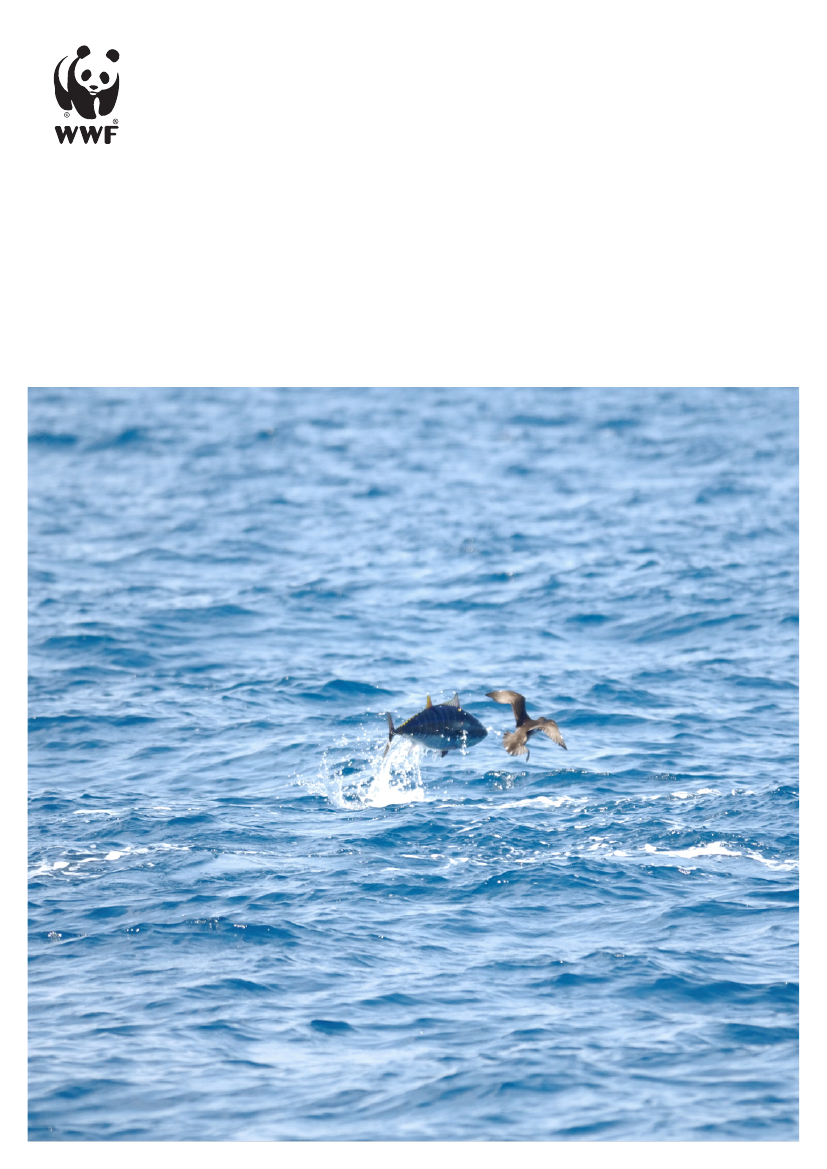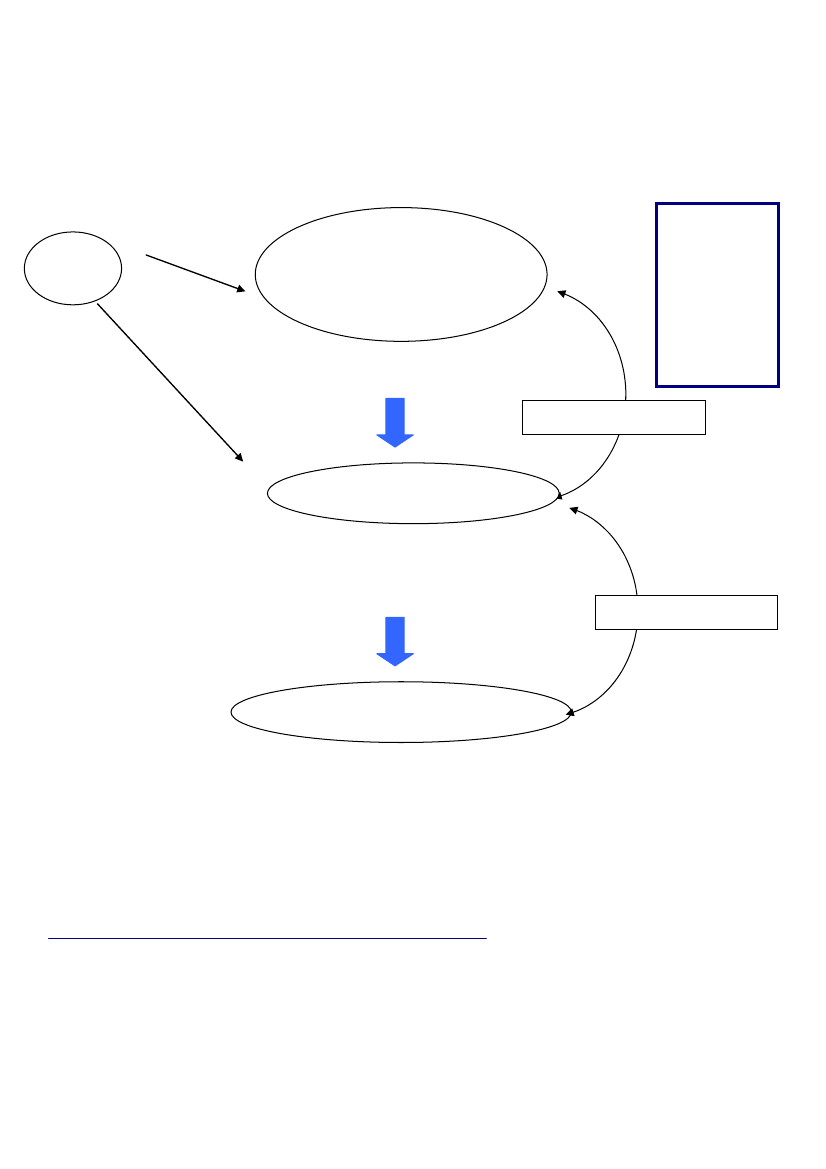Udvalget for Fødevarer, Landbrug og Fiskeri 2009-10
FLF Alm.del Bilag 250
Offentligt
WWF Response to the2009 Green Paper :Reform of theCommon Fisheries Policy
Published November 2009 by WWF, World Wide Fund for Nature (formerly World Wildlife Fund), Brussels,Belgium. Any reproduction in full or in part of this publication must mention the title and credit the above-mentioned publisher as the copyright owner.� text 2009, WWF. All rights reserved.Editor: Helen McLachlan, WWF-ScotlandLayout: Florence Danthine and Stefania Campogianni, WWF European Policy OfficePrinted on recycled paper.Photo: � WWF/ F. Bassemayousse
WWF Response to the Reform of the CommonFisheries Policy Green Paper 2009
Table of ContentsExecutive summary ………………………………………………………………………………………………..2Fleet Overcapacity ...................................................................................................................................... 3Focussing the Policy Objectives ............................................................................................................... 6Focusing the decision-making framework on core long-term principles ............................................. 9Encouraging the industry to take responsibility in implementing the CFP........................................ 15Developing a culture of compliance ....................................................................................................... 18A differentiated fishing regime to protect small-scale coastal fleets.................................................. 23Making the most of our fisheries............................................................................................................. 25Relative stability and access to coastal fisheries ................................................................................. 28Trade and Markets .................................................................................................................................... 30Integrated Maritime Policy ....................................................................................................................... 33Scientific Advice (Further improving the management of EU fisheries & the knowledge base forthe policy) .................................................................................................................................................. 35Structural Policy and Financial Support................................................................................................. 37External Dimension................................................................................................................................... 39Aquaculture ............................................................................................................................................... 45
1
Executive SummaryWWF believes there is hope that sustainable fisheries management can be achieved inEuropean fisheries. Our vision is one of healthy marine ecosystems supporting abundant fishstocks which in turn provide sustainable livelihoods for fishing industries and fisheriesdependent communities around the world. We therefore welcome this opportunity to presentour views on the Common Fisheries Policy (CFP) reform. In our response we propose that therevised CFP Regulation establishes a mandatory requirement for all European fisheries tooperate according to ecosystem based Long Term Management Plans (LTMPs) by 2015. TheRegulation should standardise these by setting out minimum criteria that all plans need to meet,including balanced stakeholder groups that will develop the plans for European Parliamentaryand Council approval, thus delegating more responsibility to the industry and otherstakeholders. Adopting this approach will allow the EU to address its environmentalcommitments under the Marine Strategy Framework Directive (MSFD) as well as institute asound model for the regionalisation of the CFP and the much needed devolution of decisionmaking.This approach addresses the five main structural failings identified in the greenpaper in the following way:A deep rooted problem of overcapacity.WWF agrees that without tackling overcapacity allother initiatives will be undermined. One of the criteria we recommend for the LTMPs is anassessment of capacity, and where overcapacity is identified within the fishery, a capacityreduction strategy must be agreed and implemented.Imprecise policy objectives resulting in insufficient guidance for decisions and implementations.LTMPs will provide clear management strategies for all fisheries, setting unambiguous,timebound targets and harvest control rules as well as strategies for addressing ecosystemimpacts.A decision making system that encourages a short term focus.LTMPs will establishmanagement in a long term framework and stakeholders should be incentivised by the benefitsthat such a management strategy should deliver, maximising returns over time.A framework that does not give sufficient responsibility to the industry.The balancedstakeholder groups that we propose to agree and implement the LTMPs have the industry askey players co-managing the fishery alongside government managers, scientists, controlagencies and environmental interests. Industry will have significantly increased responsibilitiesif they choose to engage in these fora effectively.Lack of political will to ensure compliance and poor compliance by the industry.Through theuse of more inclusive stakeholder groups to develop and deliver LTMPs, the provision of rightsbased management, and the use of appropriate incentives there should be greater complianceby industry as the rules will be largely of their own making. Sufficiently harsh penalties for noncompliance will also play a key role.Our approach of adopting effective ecosystem based LTMPs alongside improved control andcompliance, and standardisation of procedures such as penalties and data collection, across theEU should set us on a firmer footing towards the more economically desirable prospect ofsustainable European fisheries. We advocate that the same approach should govern EU fleetactivities wherever they fish and should guide EU external relations with third countries, inRegional Fisheries Management Organisations and in Fisheries Partnership Agreements.
2
Fleet OvercapacityIt is vital that a balance is achieved between fisheries resources and fleet capacity if theproductive potential of Europe’s marine waters is to be realised. As the Green Paper rightlystates, the future CFP must have in-built mechanisms to ensure that the size of the Europeanfleets is adapted and remains proportionate to available fish stocks, and that this is a pre-requisite for all other pillars to work. Overcapacity must be addressed as a priority.A fundamental change in how we manage Europe’s fishing fleets is needed and key to this willbe that all European fisheries are managed according to ecosystem based Long TermManagement Plans (LTMP) which adhere to strict criteria established in the reformedRegulation. Adopting such an approach will provide the framework not only for setting andachieving sustainability goals but also for the new regionalisation of the CFP.We set out our model for LTMPs later in this document (in answer to questions 8 & 9); one ofthe elements that WWF believes must be incorporated into each Plan is an assessment ofcapacity within the fishery and where overcapacity is identified, acapacity reduction strategyshould form part of the formal LTMP, with co-ordination at Regional level for implementation atMember State level. Balancing capacity to resources will in essence become one of the targetsof the LTMPs; targets will be time limited, and penalties will be incurred for failure to fulfil.There is a need to establish a common definition of capacity to avoid using crude physicalattributes that cannot and do not provide genuine measures of fleet capacity. For example,vessels of similar size may deploy very different levels of fishing power, depending on the gearused. Similarly, engine size may be highly relevant in some cases (e.g. trawl fisheries) and lessso in others.FAO defines fishing capacity as:The amount of fish (or fishing effort) that can be producedover a period of time (e.g. a year or a fishing season) by a vessel or a fleet if fully utilized and fora given resource condition. Full utilization in this context means normal but unrestricted use,rather than some physical or engineering maximum.The FAO definition combines two basicand complementary approaches to managing fishing capacity: ‘input based’ and ‘output based’.Input based measures consider production factors used to harvest fish, such as the number ofvessels active in a fishery or the level of effort they apply ( days at sea, number of trapsdeployed, etc).1. Should capacity be limited through legislation? If so, how?Limits on capacity should be contained in legally binding measures. As outlined above WWFbelieves that balancing capacity to available resources should form one of the mandatorytargets in a formal LTMP, as specified in the Regulation. Each LTMP will have the requirementto assess capacity as part of the overall descriptor of the fishery (Member States should berequired to provide the necessary fleet information in a consistent manner). Where overcapacityis identified a capacity reduction strategy must be developed as part of the LTMP.It will be necessary for the assessment to be carried out at fishery level which will be Regional inmost cases. Where there is only one Member State prosecuting a fishery it will be at MemberState level. A capacity reduction strategy will need to be agreed at this level, agreeing targetsand timelines for reduction. It is likely that the details for meeting targets will then beimplemented at Member State level.
3
Where overcapacity is not identified, the assessment can be used to meet the legal requirementfor a strategy – ie. it can be demonstrated that there is no need for a capacity reduction strategyin that instance. Member States failing to provide information should face meaningful penalties,such as financial sanctions and/or a quota decrease or zero quota.The appropriate level of capacity is closely linked with the status of stocks; as stocks improve ordecrease the capacity limit can therefore vary. Legislative tools to limit capacity will need to becarefully structured so that they are not too rigid to react to resource fluctuations.2. Is the solution a one-off scrapping fund?A one-off scrapping fund would not solve the problem of overcapacity. In the first instance thereare indications that Member States would be unwilling or unable to meet match funding requiredfor such a scheme even if it were available, and secondly it is unclear whether the right vesselswould be removed from the system.In July 2008, the EU adopted an emergency package of measures to tackle the fuel crisis in thefisheries sector - the Fleet Adaptation Scheme (FAS) - which was primarily anad hocspecial,temporary regime derogating from some provisions of the European Fisheries Fund (EFF)regulation for a limited period (up to the end of 2010). The FAS constituted an experiment in thefeasibility of a one-off scrapping fund and the results suggest that the scheme was notsuccessful as Member States failed to use the FAS to restructure their fleets due to the highinitial costs.However at Member State level capacity reduction measures such as transferable fishing rightshave been implemented in Scotland and Denmark at minimal governmental cost. This has freedresources for subsequent sectoral research and innovation investment1. France and Italy arealso starting to reduce their fleets significantly. Italy is dismantling purse seine vessels: 19 in2009 giving a 28 % capacity reduction, and 12 more in 2010 representing a 24% capacityreduction.WWF believes that the approach of a capacity reduction scheme within an LTMP will provide amore flexible, realistic and effective way forward for Member States to reduce overcapacity,more in line with the Danish and Scottish examples. It may be helpful for Community money tobe made available to support individual capacity reduction strategy objectiveswhere these aredemonstrably in line with sustainability targets.3. Could transferable rights (individual or collective) be used more to support capacityreduction for large-scale fleets and, if so, how could this transition be brought about?Which safeguard clauses should be introduced if such a system is to beimplemented? Could other measures be put in place to the same effectThe use of rights based management tools is already a fact of life throughout the EuropeanUnion, taking many different forms. A recent evaluation found that all coastal Member Stateshave already implemented some type or types of RBM.2MRAG, IFM, CEFAS, AZTI Tecnatio & PolEM (2009). An analysis of existing rights based management(RBM) instruments in Member States and on setting up best practices in the EU, Final Report. London:MRAG2MRAG, IFM, CEFAS, AZTI Tecnatio & PolEM (2009). An analysis of existing rights based management(RBM) instruments in Member States and on setting up best practices in the EU, Final Report. London:MRAG1
4
If properly designed, RBM schemes can be successful at providing long-lasting cost-effectivesolutions to the overcapacity problem, while enhancing economic efficiency, assisting wealthcreation, and enhancing the overall environmental performance of a fishery. Such an approachcan also provide for a solution to phase out dependency on subsidies and in return achieve abalanced fleet.WWF believes that transferable rights could form one of the tools within a Long TermManagement Plan (LTMPs), and that where any rights based system is developed, it should bedone within the context of the LTMP.A complicating factor, potentially limiting the application of a consistent rights-based approach iswithin a LTMP comprising several Member States with different RBM systems. In this situation,we would envisage that the fundamentals of the rights based system (basic mechanism,legality, security) are agreed as a priority in the drafting of the plan by the authorities inagreement with stakeholders, but over time the rights-based approaches of the various MemberStates will evolve to complement one another and the LTMP itself. The advantages of such asystem are that any disagreements or conflicts between systems can be dealt with at theconception stage of the LTMP, and through negotiation between the stakeholder constituents.In accordance with our views of how the inshore zone should be managed, WWF supportstailoring RBM schemes that grant fair and equitable user rights to local and sustainable coastalfleets, and that encourage the allocation of such shares for minimally destructive vessels. Suchpreferential treatment must not however be to the detriment of the target stocks, the widermarine environment or the overall objectives of the LTMP.One example of tailoring a scheme in such a way is the Cape Cod Hook Fishermen whoadopted a community ownership model. To prevent large industry take over of their tradeablequota shares they established a Trust which runs a non-profit permit leasing business that buysquota, aggregating it and associated permits into a pool, and leases quota at affordable rates toqualifying Cape Cod fishers, prioritising local and sustainable fishers who comply withmonitoring and regulations.WWF supports the idea of promoting rights based management systems on the level of acommunity, cooperative, or nominated representatives of a group, which then allocates andmonitors use of the resource.A second example is the Spencer Gulf Prawn Fishery in South Australia which uses IndividualTransferable Quotas (ITQs). Both have explicitly defined user rights and in both cases, securityof access to the resource and responsibilities of use are clearly defined and legally binding,which has been shown to further long-term sustainable use.The effectiveness of any rights-based management systems will depend on the model used, theinstitutional approach (market versus community-based), how rights are specified, theconditions under which they can be transferred, the duration of the use-rights, and the basis forallocating of the rights. Key to any RBM scheme will be legal basis of the scheme and thesecurity of the right/access.WWF supports the requirement to review RBM programs after an appropriate time and refine
5
them, if necessary, to meet the goals for the fishery or region. The review period will be specificto the fishery or fisheries under the management regime and should enable MS governments inconjunction with the Regional body to alter/adjust their fisheries management priorities.4. Should this choice be left entirely to Member States or is there a need for commonstandards at the level of marine regions or at EU level?Decisions about the allocation of fishing rights is a matter of decision for national governments ratherthan the EU. Since this is the case, the Common Fisheries Policy, which addresses EU fisherieslaw, does not directly control — either to limit or to promote — Member States' use of RBM tools.There has been concern that the benefits of a rights based system would be undermined if somefleets in a region had it and others did not. However as noted in answer to question 3we believethere is scope for a means of harmonisation through the LTMP process.Under a system whereby all fisheries are subject to ecosystem based LTMPs we envisage that arights based management scheme could be co-ordinated at a Regional level in order to standardisethe approach taken by different Member States targetting the same stock.
Focusing the Policy ObjectivesWWF strongly advocates that the EU move as rapidly as possible to an Ecosystem-BasedFisheries Management (EBFM) system, given the failure of the current single-speciesmanagement model to deliver on conservation goals and the need to address wider ecosystemimpacts of fishing activities.There are many interpretations of ecosystem-based management approaches and differentterms in different socio-political and cultural contexts worldwide. However, OSPAR, HELCOMand the EU Marine Strategy Framework Directive (MSFD), based on a recommendation byICES, consistently define EBM as “thecomprehensive integrated management of humanactivities based on the best available scientific knowledge about the ecosystem and itsdynamics, in order to identify and take action on influences which are critical to the health ofmarine ecosystems, thereby achieving sustainable use of ecosystem goods and services andmaintenance of ecosystem integrity”.3With respect to achieving EBM, the best approach is often to start with societal objectives (e.g.,as reflected in relevant policies - in an EU context these will be the CFP and MSFDcommitments), and then to assess the greatest threats to achieving those objectives. Withcurrent management practices, fisheries will often emerge as being a source of importantobjectives and also the source of a number of different threats (over-exploitation of targetspecies, impacts on conservation species, impacts on critical habitats, etc.). As long as thosethreats are not swamped by impacts from other sectors, they will be mitigated at least by takingaction in the fisheries sector, with or without collaboration with other sectors4. So it is importantthat the CFP adopt as strong an Ecosystem-Based Fisheries Management (EBFM) approach aspossible as the delivery on EBM by the CFP alone can be considerable, regardless of action byother sectors.
http://ec.europa.eu/maritimeaffairs/msp/020709/verreet_en.pdf&http://www.ospar.org/content/content.asp?menu=00180302000066_000000_0000004Rice et al (2009) Managing ecosystems, managing fisheries: how do ebm and ebfm relate? MEAM Vol2, No 2 (dec08-feb 09)
3
6
For the purposes of the CFP reform EBFM would represent a significant step in the rightdirection; as it presents a more holistic approach to secure healthy and sustainable fisheriesthat restore and conserve fish populations.5. How can the objectives regarding ecological, economic and social sustainability bedefined in a clear, prioritised manner which gives guidance in the short term andensures the long-term sustainability and viability of fisheries?As the Green Paper notes, today ecological, economic and social considerations are all givenequal weight in the CFP. The Council of Ministers, reaching decisions under the framework ofthe current Policy, considers itself free to set TACs and quotas that place short term socio-economic concerns ahead of ecological considerations – in effect spending long term capitalassets rather than living off the interest that would be accrued by sustainably managing theresource. Analysis shows that the Council of Ministers routinely over-ride the ecological adviceprovided by the Commission in setting catch limits5(and the European Commission’s proposalsare frequently watered down versions of the scientific advice they received from ICES) resultingin quotas constantly being set on average 40% over scientific advice.The CFP should reflect the fact that without a healthy marine ecosystem, a thriving fishingindustry cannot exist; fisheries are dependent on fish, fish are dependent on functioningecosystems. There is ample evidence that, in fisheries that have been subject to a morerigorous prioritisation of ecological sustainability, recovery has been attainable. For example, inthe US, their fisheries legislation6requires regional fisheries management councils to set annualcatch limits no higher than the levels of allowable biological catch established by their scientificand statistical committees, to ensure overfishing does not occur, by no later than 2010 forfisheries subject to overfishing and by 2011 for all other fisheries. In 2008, the US reported asignificant increase in stocks rebuilt. Overall, US results are far better than the EU’s with 16% ofstocks subject to overfishing in 2008 and 23% in an overfished state, compared to 88% in theEU.7WWF calls for a prioritization of the pillars to enable a recovery of marine ecosystems andrelated priority fish stocks. In policy terms this would mean that Ministers are only able to setharvest targets within harvest strategies that include biological limits based on the precautionaryprinciple outlined by the scientific advice.The current objective states“the Common Fisheries Policy should therefore be to provide forsustainable exploitation of living aquatic resources and of aquaculture in the context ofsustainable development, taking account of the environmental, economic and social aspects ina balanced manner,”(EC 2371/2002). Apart from giving precedence to ecologicalconsiderations, a clarification of economic aspects could also improve the CFP. Evidenceshows that, over the medium to long term, allowing European and global fisheries to recoverwould result in a far more profitable industry. One study identified that allowing European fishstocks to recover to MSY levels could generate 400,000 tonnes of additional catch.8The WorldBank & FAO report, “Sunken billions” concluded that globally economic losses in marine5
WWF, 2007. Mid-Term Review of the EU Common Fisheries Policyhttp://assets.panda.org/downloads/wwf_cfp_midterm_review_10_2007.pdf6Magnuson-Stevens Fishery Conservation and Management, amended 200772008 Status of US Fisheries, Report to Congress, NMFS, May 2009,www.nmfs.noaa.gov/sfa/status offisheries/sosmain.htm8MRAG, 2009. Studies supporting reform of the Common Fisheries Policy, A vision for Europeanfisheries post 2012. A report for WWF by MRAG
7
fisheries resulting from poor management, inefficiencies, and overfishing add up to a staggeringUS$50 billion per year9In addition, current economic analyses usually fail to account for the other ecosystem servicesprovided by a healthy marine ecosystem, such as climate regulation, tourism values, etc.10Bybroadening the definition of economic benefits associated with sustainable fisheries and healthyoceans, the CFP would be able to more adequately consider and ‘trade-off’ both the net benefitsand losses of different levels of marine ecosystem functioning.As the Green Paper notes, economic and social viability over the long run can only result fromrestoring productivity. To give guidance in the short term, priority must be given to ecologicalsustainability. Clear and transparent standards for fish stock abundance and timetables forrestoration of that abundance must be specified in the CFP and made binding on the EuropeanParliament and Council of Fisheries Ministers in their decision making practices.6. Should the future CFP aim to sustain jobs in the fishing industry or should the aim beto create alternative jobs in coastal communities through the IMP and other EUpolicies?It is clear that current fisheries resources will not support present levels of employment in thecatching sector and that addressing overcapacity will mean losing jobs. This is a fact and onethat needs to be managed in order to minimise hardship on fisheries dependent communities.Alternative forms of employment could be achieved through Regional Development Strategieswhere they can identify more readily the infrastructure development needed to manageemployment or unemployment in communities dependent on fishing. In support of this webelieve that EFF funds should remain available for the sector and concentrated on Axis 4investments addressing the development needs of economically depressed fishing communitiesthrough promotion of such alternatives as ecotourism and integrated coastal livelihood andmanagement programmes.7. How can indicators and targets for implementation be defined to provide properguidance for decision making and accountability? How should timeframes beidentified for achieving targets?Clear targets for fisheries management are essential and at the highest level there are someobvious commitments that Member States need to be guided by and build into the newRegulation. For example there are requirements under the Marine Strategy FrameworkDirective (2008/56/EC) to:••Achieve and/or maintain good environmental status (GES) following the qualitativedescriptors (listed in Annex 1) in the marine environment by the year 2020 at the latest,and;To achieve Maximum Sustainable Yield Targets and other management objectivestowards ecosystem level sustainability by 201511(as an intermediate goal towards
9
WB-FAO, The Sunken Billions - The Economic Justification for Fisheries Reform,http://www.globefish.org/files/Sunken%20Billions%20Report%20Advance%20Edition_659.pdf10Millenium ecosystem assessment. Current state and trend assessments, chapter 18 marine systemshttp://www.maweb.org/en/Condition.aspx#download11Under the EU Sustainable Development StrategyObjective 3: Improving management and avoidingoverexploitation of renewable natural resources such as fisheries, biodiversity, water, air, soil and
8
higher precautionary biomass levels compatible with GES in 2020) as practical targetsfor decision making and accountability.These should form the high level objectives that will guide the development of ecosystem basedLTMPs and that within each LTMP there will be a series of indicators and interim targetsestablished that will track progress and assist in delivering these. LTMPs should establish thetimelines within which the targets should be met.The balanced stakeholder groups that we recommend formulate plans should include scientistsas well as managers, industry and environmental interests which should help in arriving attargets based on best scientific advice and that make all stakeholders accountable for trackingand achieving them.It is likely that a raft of targets will be established in order to meet high level objectives. Forexample, identifying critical or sensitive habitat impact and how this can be avoided by thefishery, capacity reduction where it is identified as a problem, and discard and bycatchminimisation.The GES process will start to roll out during the period of the reform. Detailed indicators must berolled out by 2010 and an initial assessment of the state of the seas to be completed by 2012.The results of this work will inform the LTMPs and the move towards good environmental status.
Focusing theprinciples
decision-making
framework
on
core
long-term
8. How can we clarify the current division of responsibilities between decision-makingand implementation to encourage a long-term focus and a more effectiveachievement of objectives? What should be delegated to the Commission (inconsultation with Member States), to Member States and to the industry?9. Do you think decentralised decisions on technical matters would be a good idea?What would be the best option to decentralise the adoption of technical orimplementing decisions? Would it be possible to devolve implementing decisions tonational or regional authorities within Community legislation on principles? What arethe risks implied for the control and enforcement of the policy and how could they beremedied?Reform of the governance structure for the CFP will be vital. In line with an ecosystems basedapproach there needs to be a shift towards a fisheries management policy where outcome-based macro level objectives are set centrally and are then delivered at a regional and MemberState level and where clear accountability mechanisms are built into the system. This approachwould reduce dependency on the Council for annual fishery management decision making andprovide stakeholders with a greater sense of ownership for the management of fisheries.Of the options considered in the Green Paper we therefore favour the one whereby actualmanagement takes place at a Regional and Member State level but is based on standardised
atmosphere, restoring degraded marine ecosystems by 2015 in line with the Johannesburg Plan (2002)including achievement of the Maximum Yield in Fisheries by 2015.
9
decisions and principles agreed at Community level. Critical to this approach will be to achieveprinciples which have environmental sustainability as a priority and are based on sound science.The key to delivering decentralization of decision making and providing the way forward on longterm sustainability is amandatoryrequirement for all European fisheries to be managedaccording to Long Term Management Plans (LTMPs). The new Regulation should make this amandatory requirement by 2015. By committing to this the next step will be establish what themanagement unit of the plans will be and this in turn will guide the regionalisation process.The swift and systematic adoption of well designed LTMPs will allow Member States to manageEU fisheries on a multi annual basis, in line with the precautionary principle and an ecosystemsbased approach. In turn, this will contribute to achieving good environmental status (GES), asrequired under the Marine Strategy Framework Directive (MSFD).Instead of LTMPs being developed largely on a single stock basis these plans need to addresseither a fishery or a particular area. This will ensure that stakeholders who have an interest inthe fisheries within that area or fishery can contribute to their management. Recent researchhas confirmed that the most effective way to achieve sustainable fisheries is with science-basedLTMPs arrived at via open and transparent stakeholder processes.12. As discussed above, weare supportive of the transition to a system whereby the European Council, Parliament andCommission set overall objectives for ecosystem health and stock abundance based on thelatest science, and those objectives are translated by Regional and Member State stakeholderbodies into LTMPs that can deliver on the overall objectives. Objectives should be revised andprioritised to be clear, straightforward and consistent. Well-defined and prioritised objectivescontribute to long-term management by producing clear guidelines, which make the processand outcome of implementation more consistent.The revised CFP Regulation needs to establish:----Amandatory requirementfor all European fisheries to be managed by LTMPs by acertain date (we suggest 2015).The high levelsustainability objectivesof the plans such as achievement of MSY by2015 (and MEY by 2020) and a commitment to fulfilling the relevant MSFD goals.Establishclear criteriafor what elements need to be included in the development andimplementation of plans.Clearaccountabilityfor failure to develop plans within the required time and penaltiesfor failure to comply with plans once agreed.
Key to the success of the plans will be the criteria and their implementation. These wouldinclude:1. Plans are fisheries based or region based instead of stock specific. This is a major changefrom what is happening at present, and will be one of the main issues to address but isessential if we are to take an ecosystems approach.2. Balanced stakeholder group(s) need to be established, as well as a means of co-ordination at a Regional level. Plans need to be agreed, implemented and reviewed by12
Camilo Mora, R. Myers, M. Coll, S. Libralato, T. Pitcher, R. Sumaila, D. Zeller, R. Watson, K. Gaston,B. Worm, «Management Effectiveness of the World's Marine Fisheries,» PloSBiol 7(6):e1000131.doi:10.1371/journal.pbio.1000131 .
10
these balanced stakeholder groups, which should include government managers,scientists, industry (processors as well as catching sector), control agencies and NGOs.3. Description of the fishery(ies) – this should include vessels, gear, species, economics(revenue, management costs), employment as well as any recreational interests.4. Plans are ecosystem based – they need to introduce impact assessments (takingaccount of a wider range of impacts on target and non target species (including non fishspecies) and habitat, as well as the impact of other fisheries/activities on the targetspecies within a fishery).5. Management is based on total removal rather than landings.6. Analysis and risk assessment are used to address data poor fisheries and allowprecautionary quotas to be set.7. Clear targets and timelines are set, and unambiguous harvest control rules, to determinecatch level or effort, are established.8. The plans will need to establish targets other than simply stock and will be informed bythe impact assessment process. These could include, discard and bycatch minimisationplans, habitat protection strategies.9. The fishery should also be assessed for overcapacity which if identified should require astrategy to bring it into line with resources. Detailed capacity reduction would likely bedelivered at Member State level. A marketing strategy (which would help maximiseeconomic return) would also be useful at Member State level.10. Effective monitoring and control requirements.11. Formal penalties for failure to comply. These need to be standardised across MemberStates, consistent with the EU’s new Control Regulation where applicable.12. Triggers for fisheries, which would warn when management has to shift from rebuildingto recovery mode, are established in the plan.13. Formal periodic review and ability to adapt or be flexible in face of new data.There would need to be a regional body that had an overview of the region to ensure that theplans within any one region were compatible and together would not result in an area becomingover exploited. Once agreed at a Regional level LTMPs would be submitted to the Commissionwho would likely seek initial scrutiny jointly by STECF, a DG Environment equivalent andpossibly an evolved form of the RACs.The Commission will need to feel confident that agreed plans meet the Regulation criteria andstand a good chance of meeting the targets. They will also have the right to take action wherethere is failure to meet the criteria, or where plans are not forthcoming in line with requireddeadlines. The final approval of an LTMP will of necessity remain with the Parliament andCouncil under the Treaty although this approval would be expected to be routine under theproposed schemeIf approved it is then incumbent on the Member States to implement the plan with stakeholdersat the fishery level. At this level there will be the need to create Member State Co-managementCommittees (CCs) for each LTMP. Composition of the CC needs to include relevant industryrepresentatives (incl catch sector and processors), national decision-makers, national/regionalscientists, control authorities & environmental interests including NGOs. It will be this body thatis responsible for the day to day implementation of the plan.The whole system will be transparent – this will be enabled by the full description of the fisheryrequired to guide the development of the plan – and based on sound science. Periodicperformance reviews of LTMPs against common standards would be carried out by STECF &
11
DG Environment, with participation of scientists involved in CCs, and, as a result, mandatoryadjustments could be requested of CCs.It should be noted that there may be instances where a fishery is only prosecuted by oneMember State in which case the Member State in question would fulfil the role of bothdeveloping and implementing the plan. The plan would still need to demonstrate its compatibilityat a Regional level and be signed off by the Commission, Parliament and Council.Diagram 1provides a visual map of this new regionally based governance structure.WWF believes that an effective marketing strategy should form a key component of sustainablefisheries management. This should maximise economic return and factor in continuity of supplyresulting in the much desired end point of removing less from the sea but achieving moremoney for what is removed. A marketing strategy may be most appropriate at a Member Statelevel as markets will vary between Member States and there may be competition betweenMember States. As such we would not envisage that this is a mandatory requirement but wouldlike to see such an approach being adopted at implementation level.In future LTMPs it would be useful to look at the concept of biomass removal to allow amore comprehensive ecosystem approach but given current data and resources this may bebeyond the capabilities of this reform process timeframe. It should however be something thatis planned for in future management.Adopting an effective framework such as this alongside strong criteria to guide the developmentand delivery of LTMPs maximises the chances of meeting MSFD commitments. The criteria areessential if this is to work and without them there is a very real chance of failure.It is also key that strong and clear accountability measures are built into the Regulation.Member States failing to agree effective LTMPs for their fisheries must face meaningfulpenalties, such as financial sanctions and/or a quota decrease or in extreme cases, zero quota.As in the US system failure of the regional body to put forward a plan meeting statutoryrequirements results in the Federal fisheries director stepping in to develop a plan, failure byMember States to meet the deadline could result in the Commission imposing an LTMP for thatparticular fishery as an emergency measure.For more detail on our Long Term Management Plans proposal we append our paper on thistopic. It can also be found at the following link:http://www.panda.org/what_we_do/how_we_work/policy/wwf_europe_environment/initiatives/fisheries/publications/?179101/2012-Common-Fisheries-Policy-Reform-Long-Term-Management-Plans-and-Regionalisation-of-EU-Fisheries
12
DIAGRAM 1: FRAMEWORK FORIMPLEMENTING LTMPS AND DELIVERING REGIONALISATION
ICES
EUROPEANCOMMISSION/PARLIAMENT/COUNCILLEVELAgree management plan unit (fisheries/region)and establish Regional LTMP stakeholder group(s)1
AdvisorySTECF21. RAC2. ACFA
Feedback/Review
REGIONAL LEVEL
Multi Member States Stakeholder Group(s)1develop andagree plan(s) for submission to Commission/Council forapproval3
Feedback/Review
MEMBER STATE LEVEL
Establish co-management committee1to implement plan onday to day basis and report back to regional body
123
Mixed stakeholder group (government, scientists, fisheries, processors, control, NGOs)
Currently there is no ICES advice for the Mediterranean. Main guidance on Mediterranean forCommission comes from STECFIt is likely that this will be multi Member State but in some instances where only one Member Stateprosecutes the fishery then it will develop the plan to implementation level, ensure compatability atRegional level and submit directly to Commission.
13
10. How could the advisory role of stakeholders be enhanced in relation to decision-making? How would ACFA and the RACs adapt to a regionalised approach?History has demonstrated that key to effective fisheries management is the inclusion of fisheriesstakeholders. WWF views effective andbalancedstakeholder participation to be critical to thesuccess of the development and implementation of LTMPs for all fisheries.It is likely to work best when no one interest group is overly dominant, which is the case with thecurrent RACs where a two thirds industry to one third other interests balance exists. WWF seeLTMPs being developed by stakeholder groups more mixed than the RACs. At Regional levelthis needs to include Member State representatives, control agency representatives, scientistswith appropriate knowledge of the fishery (possibly 2-3 for the plan regardless of number ofMS), a limited number of key catching sector representatives (3-4 max for each MS),environmental interests (1-2 for each MS, in reality likely to be less given available capacity). Atthis level the fundamental components of the plan(s) for shared stocks will be developed andagreed.This does not mean that there is no role for RACs but simply that in their current form we do notbelieve they should be considered the appropriate stakeholder group for development of plans.Instead it is likely that RACs will continue to play an advisory role to both LTMP Regionalstakeholder groups and/or the Commission on aspects of management through the process ofplan review.These LTMP stakeholder fora will facilitate a much more effective form of engagement for allconcerned because they will be fishery focussed and all members will therefore have the longterm interest in the same fishery as their central concern. A more mixed group should bepossible to achieve at different scales, regardless of how big or small, which is a vitalconsideration given the aspiration that all European fisheries are covered by LTMPs. Some keyelements will be essential to enhance the role of stakeholders in any fora and these include.•Fair representation•Transparency•Good access to science•Training in fisheries management•Provision of incentives to stakeholders•Holding stakeholders accountable for meeting their management responsibilities.•Access to environmental justice•With respect to RACs and their ongoing advisory role, WWF have identified a number of actionsto improve the way they function and arrive at decisions and recommendations13. Werecommend that these improvements be undertaken without delay as the RACs will play animportant continuing role during the 2010-2012 period.With respect to ACFA it may be that its role will become redundant over time given the keyrequirement to have scientists and managers actively participating in the new stakeholderbodies. It is hard to say but if the new system arose as we describe it we would not envisagefighting to retain ACFA as yet another advisory body in the process as we feel the new structurewould have good checks and balances built in.
13
WWF, 2009, How to improve the Regional Advisory Councils.http://www.panda.org/eu/fisheries
14
From the perspective of environmental justice there is a need for explicit recognition that therole played by stakeholder groups in decision-making processes gives them, and theirconstituent members, the right to challenge the legality of the acts and omissions of the ECinstitutions in the European Courts of Justice.
Encouraging the industry to take responsibility in implementing theCFP11. How can more responsibility be given to the industry so that it has greater flexibilitywhile still contributing to the objectives of the CFP?As outlined above we believe that the adoption of LTMPs and the stakeholder groups requiredto establish and implement them provide stakeholders with greater responsibilities for thefisheries they are involved with, and the management process.Using this model the central (Brussels) governmental role is to provide long-term policy andoutcome-based targets with the Regional and Member State levels responsible for thedevelopment of technical means to meet them. The decision-making process becomes moreflexible and responsive to local conditions, and enables active stakeholder engagement in localpolicy and technical implementation decision processes. This would allow different regions toutilize different tools, better suited to their circumstances.WWF believes that the development of this kind of framework approach and building strongpartnerships between industry, management and science are important to generate confidencein management, and to encourage a better culture of compliance. Once such a framework is inplace the role of the Council and Parliament in approving management plans should be one ofroutine oversight, rather than micromanagement.12. How could the catching sector be best structured to take responsibility for self-management? Should the POs be turned into bodies through which the industrytakes on management responsibilities? How could the representativeness of POs beensured?A system of participatory governance or co-management is an institutional context that, if welldesigned, can allow fishermen to participate in fisheries management decision making. It can bea successful dynamic partnership using the capacity and interest of user-groups and becomplemented by enabling legislation and other administrative requirements14. Fishermen canbe part of the decision making process and work with Member States and other stakeholders toensure that long-term management objectives are met. It can also improve fisher support, foroutcomes, confer legitimacy on the regulations and foster compliance, which may also reducemonitoring and surveillance costs15,16. Co-management is a means of building trust andempowering stakeholders to participate in the shared governance of fisheries. For moreinformation on the Co-management Committees please refer to Question 9 on Decentralization.
14
Nielsen J.R. and T. Vedsmand. 1997. Fishermen’s organizations in fisheries management:perspectives for fisheries co-management based on Danish fisheries. Marine Policy, 21: 277-28815Schumann, S. 2007. Co-management and consciousness: fishers assimilation of managementprinciples in Chile. Marine Policy, 31: 101-111.16Kuperan, K., N.M.R. Abdullah, R.S. Pomeroy, E.L. Genio and A.M. Salamanca. 2008. Measuringtransaction costs of fisheries co-management. Coastal Management, 36: 225-240.
15
It has been shown that stakeholder compliance with decisions in which they played little or norole has been mixed at best17and that key to sustainable fisheries management is the effectiveengagement of fisheries stakeholders. We believe this needs to be on a balanced basis andthat stakeholders should include government managers, environmentalists, scientists andindustry (both catch sector as well as market players to try and improve some of the economicreturns of fishing).Existing Producer Organisations (POs) are not homogenous in how they operate in relation totheir members. In some instances it may make sense for POs to act as management bodieswhilst in others it won’t and some may be able to transform themselves into becoming a suitableco-management partner.It is clear that there is a need for the appropriate level of representation at the local and regionalstakeholder level which can talk on behalf of the catching sector. Without achieving this there isa high risk that plans will flounder due to lack of support on agreed management.WWF welcomes industry’s role being extended beyond that of just quota allocation where this isdone within the structure of a co-management body. In Scotland the Conservation CreditsScheme (CCS) was launched in February 2008 with it’s overarching aim being to improvefisheries management in Scotland by adopting best practices in stock conservation, andsupporting (and ensuring) the future economic prospects of fishing communities. It is run by theScottish Government Marine Directorate (SGMD) and advised by a 25 member steering groupwith members from industry, science and an environmental NGO. The Steering Group, whichmeets monthly to assess the progress of the CCS, also provides a forum for government,science, industry and NGOs to discuss proposed measures, conferring a degree of ownershipover the process and outcomes and thus a level of buy-in from the fishing sector and others.The CCS is based on strong conservation orientated objectives. As the name implies, it creditsfishermen for adopting conservation measures with a currency of real value to them – additionaldays at sea, and the possibility to operate under the more flexible conditions of “hours-at-sea”.In Galicia, the EU’s largest fishing region, successful participatory co-management schemes arebeing adopted in the design, management and monitoring of fishing reserves or long-termmanagement plans with strong conservation and management objectives. This newparticipatory model, initially adopted in the small fishing community of Lira, is being followed bydozens of fishermen organisations in Galicia and the rest of Spain and supported by NGOs likeWWF.A planning process for any participatory or co-management scheme is essential to guaranteethe success of the scheme. Ensuring an appropriate suite of conditions and a robust processwill increase the likelihood of success, and lessons should be learnt from other similarschemes18.
MRAG, 2009. Studies supporting reform of the Common Fisheries Policy, A vision for Europeanfisheries post 2012. A report for WWF by MRAG18Chuenpagdee, R. and Jentoft, S. 2007. Step zero forfisheriesco-management: What precedesimplementation? Marine Policy, 31: 657–668.
17
16
13. What safeguards and supervisory mechanisms are needed to ensure self-management by the catching sector does not fail, and successfully implements theprinciples and objectives of the CFP?Self-management by the catching sector is not an aspiration shared by WWF for the newgovernance system. WWF believes a system of co-management is more appropriate and thatthis should be delivered by the new stakeholder groups of the LTMPs. These will include abalance of catching and processing industry representatives as well as government managers,scientists and environmental NGOs.With such a mix of stakeholders represented both at Regional and Member State level webelieve that a balanced set of objectives and targets can be agreed, as well as a means ofachieving them. All stakeholders should share the common goal to achieve a rebuilding of thefishery, minimise the environmental impact of the fishery, and ultimately witness animprovement in the economic return from the fishery, and overall health of stocks and theirsupporting ecosystem.Key to the functioning of the LTMPs will be a robust set of monitoring and control criteriaappropriate to the fishery. Incentives should be an option within LTMPs to assist withcompliance. However there will also be the need for clear penalties for failure to comply(reverting to centralised management with lower, more precautionary TACs) to be established atCommunity level and standardised across Member States.14. Should the catching sector take more financial responsibility by paying for rights orsharing management costs, e.g. control? Should this only apply to large-scalefishing?At present fisheries enforcement represents a substantial financial burden on Member States. Inseveral Member States it has been estimated that the cost of fishing to the public budgetexceeds the total value of the catches19. A considerable proportion of that cost is spent oncontrol and enforcement.Moreover, many European fleets operate at a loss, crippled by the costs of fuel and reducedfishing opportunities, and kept afloat by inappropriate subsidies. Adaptive measures such asreducing fleet size and a move towards less fuel-intensive practices are a first step towardsincreased resilience. However, actions must go further including: harmful subsidies to beeliminated and the resources redirected from fishing capacity to improved management,oversight and research. Any funds used for buyback or decommissioning must be linked tosubstantial, permanent reductions in overcapacity.There is also a clear argument for the industry themselves bearing some of the cost of theseadjustments. As an example, at present in the UK the Seafish Industry Authority, which worksacross all sectors of the seafood industry to promote quality, sustainable seafood, is fundedfrom a statutory levy on all fish, shellfish and seafood products landed, imported or cultivated inthe UK. Of an annual budget of around £11 million just under 80% is from levy. The rest comesfrom grant funding and consultancy work. The levy is due on all first-hand purchases of sea fish,shellfish, and sea fish products including fishmeal landed in the United Kingdom or from any UKregistered fishing vessel owner, fish and shellfish farmer, grower or cultivator who lands productin the United Kingdom for subsequent sale direct to a foreign customer, or who trans-ships19
Commission of the European Communities. 2009. Green paper: Reform of the Common FisheriesPolicy.
17
product within British fishery limits.A similar system could, and arguably should, be set up whereby fisheries pay a levy on fishingopportunities to support the costs of control and enforcement and other management.15. When giving more responsibility to the industry, how can we implement the principlesof better management and proportionality while at the same time contributing to thecompetitiveness of the sector?The assumption of responsibility for some of the management by the industry implies acommitment to better management principles. Such responsibility should not be given unlessthis commitment is clear. These principles lie at the core of an ecosystem-based fisheriesmanagement approach which itself rests on the principle of stakeholder involvement in objectivesetting and achievement. These principles are then operationalised through long-termmanagement plans with criteria relating to each principle. The MSC’s Principles and Criteria forSustainable Fishing, being based on the FAO’s Code of Conduct for Responsible Fisheries area useful starting point. It may also be necessary to ensure that any such industry givenresponsibility are themselves structured into formal industry associations with such principlesthemselves enshrined in the association statutes.16. Are there examples of good practice in particular fisheries that should be promotedmore widely? Should incentives be given for the application of good practices? If so,which?There are a number of examples across European fisheries, five of which have been highlightedin the WWF “Net Gains” film. These include initiatives in the UK, Greece, Spain and Denmark,adopting a range of measures including using onboard surveillance cameras to control discardsand the uptake of selective fishing.Another example is the Scottish Conservation Credits Scheme. In December 2007 MemberStates were given the flexibility to run their own days at sea scheme as a pilot ahead of futureEU-wide implementation of “effort pot” schemes, the Scottish Government took up thisopportunity and in February 2008 launched the Scottish Conservation Credits Scheme (CCS),which is explained in answer to Question 12.Effective monitoring and control will be key for the success of any plan. Stakeholderparticipation and agreement over targets is key to achieving compliance with any managementplan. That said it is well recognised that incentives can be an effective means of improvingcompliance and as such should be considered as options to be built into management plans.
Developing a culture of compliance17. How can data collection systems be improved in the short and medium term toensure coherent information for enforcement purposes?In order to improve data collection and ensure coherence for enforcement, WWF proposes thefollowing measures and issues are addressed:1. Increase Transparency
18
There is a lack of transparency and common approach in Member State reporting to theCommission on national fleet and fisheries20. A harmonised system from which consistent datacan be used by both Eurostat and DG MARE but also between Member States isrecommended21. An appropriate regional and global network to manage data should bedesigned and constructed to improve the exchange of information.2. Harmonize measuresWWF stresses the need for setting up concrete and efficient standardized actions andprocedures at sea and on land between Member States to improve the culture of complianceand data collection. This standardization should be coordinated by the Common FisheriesControl Agency (CFCA) and collected and managed appropriately. A general short-coming isthat some controlling obligations e.g. prior notification at arrival to port is not the same in allfisheries area. This is costly for both authorities and industry to handle parallel systems andshould be addressed to make the obligations standard across all Member States and fisheriesareas.According to the Commission’s analysis of the EU fisheries, 80% of the fleet are represented byvessels under 15 m22. It is crucial that such a large proportion also be included in modernisedsurveillance standards to eliminate any loopholes in the system.3. Catch and landings dataTo be effective, the EU’s overarching data management system needs to be able to collect,compare and verify input-output data. Currently this is a lengthy process involving multipleMember States’ controlling authorities. The electronic logbook should have a batch numbertracker device to enable real-time data review and crosschecking with Vessel MonitoringSystems (VMS), to detect and minimise tampering of VMS at sea. All reported information fromvessels must be electronically transmitted to a common database and accessed by MemberStates abiding by these CFP regulations. Buyer registration and submission of electronic salesnote should also be an integral component to reporting and cross checking systems.The data collection on the measure of fish catches is based, in most cases, on Total AllowableLandings in which no account is taken of discards. In 2006, ICES estimated that total removalsamounted to around three times the reported landings suggesting either under-reporting oflandings or a substantial problem with continuing discards23The accurate and timely reporting of both catch and landings data (which should be linked witheffort data) is feasible for all boats >15m. The introduction of electronic recording and reportingsystem (ERS) that has been agreed and implemented by the European Commission throughoutthe EU fleets will greatly increase the speed and accuracy of data reporting, and enable moreefficient monitoring of catches by fisheries officers. The time interval leading up to theimplementation of the system (>24m by Jan 2010 and >15m by July 2011) should ensure thatthis recommendation is implemented under the current plans of the Commission.20
COM (2008) 670 - Reports from Member States on behaviours which seriously infringed the rules of theCommon Fisheries Policy in 200621WWF (2008). Position paper; Control and Enforcement proposal,http://www.fishsec.org/downloads/1192830458_12534.pdf22European Commission (2008), Facts and Figures on the CFP23ICES (2006). Report of the Working Group on the Assessment of Northern shelf Demersal stocks, 9-18May (CM 2006/ACFM:30)
19
4. Observer coverageFor a change in the management system to be successful, sufficient enforcement and observercoverage is needed. WWF believes that there is a clear need for the use of on-board observersand video surveillance technologies (such as Closed Circuit Television - CCTV systems) tobecome a standard component of European fisheries management. This could be seen as away of increasing surveillance and baseline data, particularly if integrated with VesselMonitoring Systems (VMS). In addition, the use of e-logbooks would complement an observerprogramme. The Danish example of trialling an Electronic Monitoring System on fishing vesselsappeared to deliver sufficient reliability of the catch documentation and collection of pertinent at-sea commercial fishery data24.WWF recommends that CCTV become a mandatory requirement across fleets alongside anagreed level of spot checking by onboard observers across the fleets.5. Policing capabilities and forensic accounting worthy of the EUIntelligence, allied to online access for sales notes, can be complemented by a team offorensics accountants, with the capacity to identify any unusual behaviour. Forensicaccountants have been used in the UK and Ireland asad hocmeasures, but increasinglyinspectorates are developing their own in house forensic capacity comprising accountants, dataanalysis and investigative skills. The EU through the CFCA should systematically develop andemploy these policing techniques.18. Which enforcement mechanisms would in your view best ensure a high level ofcompliance: centralised ones (e.g. direct Commission action, national or cross-national controls) or decentralised ones?European Commission’s roleWWF supports the Commission’s suggestion to take a more pro-active role to ensure MemberStates abide by the CFP rules as proposed in the Commission’s proposal on the reform of thecommunity control system25.Member States’ roleMember States must take more responsibility for their industries behaviour and ensure legalmeasures are adequate as deterrents. WWF has strongly supported the Control Regulation’sprovision requiring harmonization of penalties across member states.Coordinated action across Member States and the ECBy allowing direct intervention and penal actions through the option as a last resort therestriction of fishing opportunities Member States are obliged to improve their own compliancesystems. However this may limit the Member States’ willingness to ensure transparency orsharing electronic data. Therefore, spot check audits by Commission inspectors should becarried out at timely intervals. The Commission Inspectors initiatives carried out in 2005-2006 inthe Baltic region comparing control and enforcement systems for the Baltic cod fishery26obliged the nations to reassess their surveillance and enforcement strategies. Fisheries control24
Jørgen Dalskov & Lotte Kindt‐Larsen National (2009). Institute for Aquatic Resources TechnicalUniversity of Denmark, Fully Documented Fishery, Mid-term status report.25COM (2008) 721 establishing a Community control system for ensuring compliance with the rules ofthe Common Fisheries Policy26European Commission, DG MARE (2007). Evaluation report of Catch Registration in Baltic SeaMember States 2005-2006.
20
information builds mainly on how the management regulations are stipulated. It is vital thatthese are outlined in a way that makes it possible to control and for the industry to comply aswell as Member States to control and cross-check.Cross-national CoordinationThe centralised planning and harmonisation of monitoring control and surveillance betweencountries in Joint Deployment Plans (JDPs) have demonstrated that increases in Monitoring,Control and Surveillance (MCS) activity are useful for many reasons, including cost savingsthrough increased efficiency, training and transfer of skills and experience. Cross-nationalinspection agreements can improve the level of compliance by Member States in regionalwaters. Given that inspection at sea in many Member States is ineffectual, expensive and notorganized, it remains crucial to coordinate available MCS resources to maximize their utility.Regional cooperation will decrease national costs and improve resource efficiency systems atsea, as well as build trust among enforcement agencies. Some effective cross-national tacticsinclude:•••Regional information sharing in real-time – information such as VMS/VDS, e-logbook,landing information could be held centrally for a regionMulti-lateral agreements on patrolling and inspection throughout a regionRegional observer and inspector training and deployment programmes
The Community Fisheries Control Agency’s (CFCA) adoption and implementation of JDPs haveproven successful in pooling resources from neighbouring Member States in regional fisheriescross border inspections27. These campaigns have improved dialogue between Member Stateson management level as well as increase the presence of inspection and in detectinginfringements that were otherwise difficult to detect. For instance the CFCA’s JDP in the NorthSea detected the use of illegal gear attachments (i.e. small mesh blinders in the cod end) onmany of their deployments 2007-200828. Increases in number and intensity of inspections canincrease compliance greatly within a number of fisheries29The Future Role of the CFCAThe CFCA can be more effective once harmonized data collection and reporting are in place.CFCA or a body of the Commission must also achieve third party control to audit and thusensure Member States adequately plans its national control resources and activities accordingto CFP rules and regulations.19. Would you support creating a link between effective compliance with controlresponsibilities and access to Community funding?Control, enforcement and an effective penalties system are central elements of all fisheriesmanagement. Currently the European Community dedicates 46 million Euros to control andenforcement, while 837 million Euros are spent on structural assistance for fisheries30. Themajority of the Community fishing fleet is dependent on funding through the European FisheriesFund as well as additional funds and subsidies. The EC should not tolerate the use of thesefunds for the purpose of sustaining non-compliant activity. By and large, with some exceptions,the measures taken by Member States since the last reform in 2002 have not been effective in2728
https://www.fiskeriverket.se/download/18.efdc1411fa22aacf0800046/arsredovisning_2008.pdfhttp://www.cfca.europa.eu/northsea/index_en.htm).29MRAG (Marine Resources Assessment Group) Ltd. (2008). Analysis of Policy to Combat IUU, A reportfor WWF Sweden.30European Court of Auditors. Special report No 7/2007.
21
encouraging the development of higher levels of compliance31,32,33The CFP should include clear legal guidelines that subsidies are to be used to achievesustainable fisheries practices. WWF’s view is that private enterprises and individual vesselsfound to have committed infringements should be barred from benefiting from public assistanceor subsidies for at least the period of the operational programme of the fisheries fund. Removalfrom the list of eligible beneficiaries should also be made mandatory so that taxpayers do notsubsidise vessels and operators convicted of non-compliant activities. Moreover, those vesselsshould not receive taxpayers’ support and vessels that have received taxpayers’ money duringthe operational programme period should be required to repay that money. Any such fundsshould be re-invested in MCS.20. Could increasing self-management by the industry contribute to this objective? Canmanagement at the level of geographical regions contribute to the same end? Whatmechanisms could ensure a high level of compliance?It is clear that there is a strong need to develop a culture of compliance among all stakeholders.This is not a simple task but WWF believes that it will be made easier by the adoption ofi)ii)iii)standardised control and enforcement systems across the EU,appropriate incentives for compliance built into effective long term managementplans, and where this fails,clear and stringent penalties for lack of compliance
Member States and the European Commission need to create, fund and implement an effectivelegal framework for the fishing industry to secure full traceability and help ensure their long termfuture. As discussed in the previous section, harmonized data collection and management areessential to an effective EU-wide system. A regime of exchanging trustworthy documentationconnected to the actual flow – and trade – of fish and fish products should be established,including mandatory compliance checks on legal documentation all along the value chain. Withthis focus, products derived from IUU fishing can be isolated from the regular market. A newmandatory system for traceability and a provision for buyers of fish and fish products to ensurethat their fish and fish products come from legitimate sources should be established.WWF considers that the fishing and processing sectors can do more to reduce IUU fishing andcomply with the CFP rules. Examples exist where the catching and processing sectors haveinvested in and introduced systems that confirm where their fish comes from and that it hasbeen caught from the permitted area, in the right way and within the quota levels.Scotland is an example where an industry led buyers and sellers registration scheme aimed ateliminating “black fish” (fish from unreported landings) from the supply chain along withincreased land-based inspection has achieved spectacular reductions in unreported landings34.
31
MRAG (2009) Studies supporting reform of the Common Fisheries Policy; A vision for Europeanfisheries post 2012. A report for WWF by MRAG32WWF (2008). Lifting the lid on Italy’s Bluefin tuna Fishery,http://www.panda.org/about_our_earth/blue_planet/publications/?uNewsID=14710333
http://europa.eu/rapid/pressReleasesAction.do?reference=MEMO/06/13&format=HTML&aged=0&language=EN&guiLanguage=en
22
In the South Georgia Patagonian Toothfish fishery, the use of a range of at sea and onshoretechnological solutions has resulted in a significant reduction in IUU fishing. These include realtime catch recording, vessel monitoring systems, bar coding, fish box identifiers and readers,combined with tougher administrative procedures. Similar measures in a ScottishNephropsfishery have resulted in, among other things, improved quality, higher value landings and lessincentive to illegally fish35.Both Denmark and Ireland are examples where Member States combine traceability withfisheries control policy as an effective measure of both eliminating IUU but also improved datacollection from the supply chain. Sales and producer organisations have proven to be effectivedirect control of fisheries. Industry can coordinate with control authority through forensicinvestigation, processing observers or other coordinated action within the marketplace.In Norway, sales organisations are used as a third body of direct control with fisheries areincluded as a required measure in their legal framework. They carry out registration and controlof catches and landings (quantity and species). All catches must be sold through theseorganisations and all landings must be weighed and recorded on the sales notes36.Along with their suppliers, seafood companies have developed and implemented voluntary,market-based schemes to remove IUU fish from the supply chain. Important best marketpractices include eco-labelling certifiable products, catch and trade documentation schemes,maintaining a fish transaction data base, publishing lists of good and bad entities, settingcorporate standards and audit procedures and partnering with the Marine Stewardship Council(MSC) or other independent organizations to maintain credibility.All of these voluntary schemes contribute to improved performance, but cannot substitute forinstitutional reform to ensure that laggards comply with the law. Effective compliance will beattained only when fisheries crimes receive the level of attention and resources that they merit.Levels of penalties against participants in IUU fishing activities and criminal networks should besubstantial enough to act as deterrents. Effectiveness of any system depends on the ability toshare the information. Regional networks with specific legal framework outlining theresponsibilities of the regional Member States obligations can ensure compliance specifically forhigh-risk IUU fisheries.
A differentiated fishing regime to protect small-scale coastal fleets21. How can overall fleet capacity be adapted while addressing the social concerns facedby coastal communities taking into account the particular situation of small- andmedium-sized enterprises in the sector?WWF understands the reason for the Commissions thinking on this point but are not convincedof the approach. Particularly in northern European waters the distinction of communities being34
Scottish Fisheries Protection Agency (2007). Annual Report and Accounts 2006-2007, Edinburgh: TheStationary Office.35Ocean Resource Conservation Associates (2006) A report to WWF Sweden on traceability and BalticSea cod fisheries.36WWF Norway (2008) Management and Technical Measures in the Norwegian Cod and GroundfishFisheries.http://assets.wwf.org.uk/downloads/norwegian_cod_fishery_report.pdf
23
dependent on small scale coastal vessels may not always be appropriate. For example somecoastal communities may be very dependent on some large vessels operating far from theirhome port but which are reliant on processing facilities etc in the local region while smallervessels may not be so vital for the overall survival of the community.A better approach is that of operating according to Long Term Management Plans (LTMPs). Asstated earlier we believe that all fisheries in Europe’s waters should be managed throughecosystem based LTMPs, which should rely on two related pillars: 1) the right ecosystem-basedfisheries management (EBFM) tools, to enable co-management and ecosystem sustainability,and 2) adequate rights-based management (RBM) tools, to ensure fishing capacity remainswithin limits compatible with sustainable exploitation of the stocks and economic profitability.This general scheme could be applied to any fishery, irrespective of its scale. This is particularlytrue for biological and ecological standards applicable to LTMPs, which should be the same EU-wide and for all fisheries (large and small scale).As stated earlier fishing access rights can be subject to trading restrictions to ensure that some‘community vital’ vessels participate in the fishery as long as such conditions are not to thedetriment of the target stocks, the wider marine environment or the overall objectives of theLTMP. In addition, harmful subsidies could be redirected to programs that transitionunsustainable employment out of the fish harvesting or processing sectors thus mitigating someof the social hardship of a transition to sustainability.22. How could a differentiated regime work in practice?23. How would small-scale fisheries be defined in terms of their links to coastalcommunities?24. What level of guidance and level playing field would be required at EU level?WWF disagrees with the principle that one should differentiate management regimes betweenlarge-scale and small-scale fleets by focusing on capacity adjustment and economic efficiencyfor the former and social objectives for the latter. On the contrary, WWF believes that balancedcapacity, economic efficiency, social aspects and ecological sustainability, should all underpinthe management of any fishery in Europe’s waters, irrespective of the scale. However key tomanagement must be the sustainability of the stock otherwise the other aspects will be unableto be met. WWF supports EFF investments in making small scale fisheries more ecologicallyand economically stable but does not believe that Europe can afford to sacrifice sustainabilityprinciples for short term economic gains in small scale fisheries any more than in larger scaleones.Small-scale fisheries, which can be less energy-intensive than larger-scale ones and canproduce a very high-quality product, highly prized by the market, can, and should, beeconomically profitable - particularly in the current environment of rising fuel prices. To achievethis, the new CFP should reward them by dropping any fuel subsidies (such as the currentdeminimisregulations), which result in coastal fisheries being out competed by frequently moreunsustainable and energy-intensive fisheries like those employing trawls. Instead, public aidshould be focussed on improving the effective marketing and selling of the product in order toachieve maximum return for the product, provide higher profit margins for fishermen, based onquality over quantity and sustainability. By doing this the current dependence on overfishing tokeep breaking even should be minimised and the position should be reached wherebyfishermen are removing less from the sea but earning more.
24
To achieve this objective it will be important to enhance the value of fishing products throughtraceability and labelling improvements, and to minimise the number of steps in the supply chainbetween net and plate. WWF France launched a project along with the Prud’homie of Saint-Raphaël which illustrates how such improvements can work in practice. This project, co-financed by Axis 4 of EFF, aims to protect the marine environment of the VAR by getting bettervalue for the fishermen refocusing attention on artisanal fishery as the centre of coastalactivities.Similar strategies are also being developed in Galicia, where fishermen-owned direct sellingenterprises improve fishermens incomes in order to reduce fishing pressure and encouragebetter practice. Commercialisation improvement strategies are often linked to sustainability andsocial-oriented programmes run by the own fishing sector37While no different ecological or management standards should be adopted for small or largerfleets, it will be necessary to apply flexible approaches to meet these objectives as in manyMember States management necessities are clearly different between small and larger fleets.
Making the most of our fisheriesThe Green Paper highlights discards, one of the most wasteful problems facing Europeanfisheries. As a means of combating discards WWF advocates the use of Bycatch Quotas.Experience from around the world suggests that this policy can be particularly effective in mixedfisheries which are a key component of European fisheries.Most EU fisheries outside the Mediterranean are managed by setting total allowable catches ofwhich each Member State get a national quota. In practice the uptake of this quota is measuredonly by landed catch, paying little attention to the levels of fish discarded. Other fisheriesmanagement regimes use quotas which limit thetotalamount of the species or population thatcan be caught, regardless of whether the catch is subsequently landed or discarded. These canbe termed “Absolute Catch Limit” (ACL). For an absolute limit on the amount that can be caughtincidentally in fisheries targeting other species, the term “Total Allowable Bycatch” (TAB) isused. TABs can be a proportion of the ACL that is caught in non-directed fisheries. Wherefisheries are primarily managed by quota, ACLs and TABs will allow accounting for all fishingmortality (Ward, 2008). In essence these “Total Allowable Bycatch” (TAB) quotas would beconsidered a cut-off value, above which a fishery would be closed. In fisheries with mixed fleets,the TAB can be divided by fleet category and managed on that basis.Where fisheries are not managed by quotas, emphasis should be made in the improvement oftechnical measures, establishment of an allowed percentage of the total catch for bycatch, andin the avoidance of certain vulnerable or sensitive areas by time/area closures.Several groundfish fisheries in Alaska have incorporated bycatch limits as a fundamentalcomponent of their management system. In Alaska, ACLs are set for many groundfish specieswhich are caught in a multi-species flatfish fishery, including yellowfin sole, rock sole, flatheadsole, Alaska plaice, Pacific cod, and pollock. Fishers have to declare a target species, but insome of these fisheries the target species makes up less than half of the catch. All fish caughtare counted towards the ACL for that species and comprehensive observer coverage is used to37
http://www.fundacionlonxanet.org
25
enforce this (100 % observer coverage on vessels over 49 m, and 30% per quarter for smallervessels). Also, the total amount of groundfish removed from the system is capped at under 2million tonnes38.WWF believes that such an approach should be incorporated into the reformed CFP within thelong term management plan framework. Such an approach offers a practical means ofaddressing the chronic problem of discarding in EU waters. Incentives should be madeavailable to make this operational and additional funding to support the management of such anapproach. Factors that generally improve the success of bycatch limits, which are in placecurrently in other fisheries globally, include high observer coverage and other measures toreduce bycatch. Other key components, such as in-season management, a strong regulatorybasis for management, and appropriate quota setting and enforcement are factors whichcomplement fisheries management system, ensuring it delivers on its sustainability objectives.25. How can long-term management plans for all European fisheries be developed underthe future CFP? Should the future CFP move from management plans for stocks tofisheries management plans?It is clear that management of EU fisheries needs to move away from stock plans to fisheriesplans. This is something which has the support of the industry39. With respect to the specificsof how we see LTMPs being developed please refer to the answer to questions 8 & 9 for thisquestion. This sets out how WWF envisages that the adoption of mandatory ecosystem basedLTMPs will not only provide the framework for managing fisheries on a sustainable basis but itwill also provide the framework for much needed regionalisation of the CFP.26. Should we consider reforming the CFP in two steps, with specific measures to moveto MSY prior to 2015 followed by measures to maintain MSY as the upper exploitationlevel after that date?The CFP should ensure that its stocks are at or above MSY as soon as possible. While somestocks are already at MSY for many this will require recovery and/or LTMPs for each fishery,with a mandatory requirement for stocks to be fished at a level not exceeding MSY in the short-term. If a stock is in a critical state and therefore subject to recovery mode management this willnecessitate lower levels of exploitation.There is growing agreement that Fmsy (the fishing mortality that delivers maximum sustainableyield) should be considered an upper limit rather than a management target reference point.However with so many EU fisheries so far from MSY WWF believes that this represents anacceptable working short to medium term goal. For long term management and for fisherieswhich are below or at MSY the alternative targets of F0.1 (a more precautionary lowerexploitation level based on yield per recruit analysis) and Fmey (the fishing mortality thatdelivers maximum economic yield) are preferable because they are generally lower risk in termsof over-exploitation than Fmsy and result in higher stock sizes and greater profitability thanwhen stocks are fished at Fmsy or similar proxy40.
38
Witherell, D., C. Pautzke, and D. Fluharty, 2000. An ecosystem-based approach for Alaska groundfishfisheries. ICES J Mar Sci, 57: p. 771-777.39NSRAC Draft Nephrops LTMP paper, April 2009,http://www.acsfilmfest.co.uk/nsrac/wp-content/uploads/2009/08/wd20090714_Draft_Nephrops_LTMP.pdf40MRAG, 2009. Studies supporting reform of the Common Fisheries Policy. A vision for Europeanfisheries post 2012. A report for WWF by MRAG
26
WWF recommends an interim short to medium target of Fmsy ie. that MSY be achieved by2015 for overfished stocks and that for those stocks below or at MSY then both MEY and F0.1should be the target by 2015. For all fisheries the aim should be to have them operatingaccording to MEY in conjunction with F0.1 by 2020 unless GES standards dictate a moreabundant target in a particular location. The reformed CFP should include a specific mandate tothis effect. Requests to ICES for advice on removals should be designed with these targets inmind.27. How could the MSY commitment be implemented in mixed fisheries while avoidingdiscards?In 2006, the Commission proposed the adoption of MSY as a target for all European fisheries,and that this should be expressed in terms of target fishing rate rather than biomass. Means ofachieving MSY need to be clearly identified in the LTMP for the fishery in question alongsideexpected timeframes. Within the targets unless it can be demonstrated that the fishery isdiscard free then a discard reduction plan needs to be incorporated.The interpretation and perception of MSY needs to be changed and clarified, particularly withinthe context of LTMPs. Ultimately achieving the MSY commitment for each species within amultiple species fishery will present a challenge as it is unlikely that MSY will be possible toachieve for all species within any mixed fishery simultaneously. It is therefore likely that acompromise will be required to maintain the fishery at an environmental and economicallysustainable level. Assessments of all species impacted will be needed as well as effort levels inorder to deliver the optimal scenario. Within this context MSY should be established as a limit,not a target, and only as a short-term intermediate management goal, with strong managementmechanisms in place to ensure this limit is not exceeded.For purposes of managing a fishery both with respect to MSY and addressing discard levelsthere is an urgent need to base management on what is being removed from the sea in the firstinstance, ie to set quotas on the basis of what is removed rather than landed. The recentstatement by Danish, German UK and Scottish fisheries Ministers to start accounting for all fishremoved with the adoption of onboard CCTV cameras is a clear and welcome contribution tothis approach41. In mixed species fisheries, WWF believes that a bycatch quota system shouldbe established for the fishery under its LTMP. Please see our introduction to this section wherewe explain this further.28. What should the main management system be for Community fisheries and to whichfisheries should it apply? Catch limitations? Fishing effort management? Acombination of the two? Are there any other options?As outlined in answer to questions 8 & 9 WWF strongly believes that the way forward is in theadoption of mandatory ecosystem based Long Term Management Plans (LTMPs) for all EUfisheries. These will provide a clear framework for managing fisheries on a sustainable basis aswell as a framework for the much needed regionalisation of the CFP.LTMPs will have the flexibility to use a range of management tools including effort and catchlimitations depending on the local conditions of the fishery. Moreover they will drive capacity
41
http://www.scotland.gov.uk/News/Releases/2009/10/08161207
27
reduction at the fishery with the accountability measures that we recommend.details please see the WWF discussion paper on LTMPs and regionalisation42.
For further
29. What measures should be taken to further eliminate discards in EU fisheries? Couldmanagement through transferable quotas be useful in this regard?A management system which limits catches rather than landings would go a long way toreducing discarding. Such a system would encourage operators to minimise the removal in thefirst instance of non target species or species for which there are lower removal rates.Supporting such an approach would be the adoption of discard reduction strategies withinLTMPs. An assessment of the fishery would be a key element of a LTMP and would assessdiscard levels as well as impacts of the fishery on other non target species and habitats.If discarding is not revealed as a problem then of course no strategy is required. However,where discarding is revealed then a strategy for discard mitigation will need to form one elementof the plan. Discard reduction targets and timelines should be established and a means ofmeeting these clearly set out. Appropriate tools will include area avoidance at pre-agreed times(known aggregating areas such as nursery, feeding etc) or in real time – ie. when juveniles orundersized individuals are identified, use of alternative gear, or adoption of bycatch quotas forsome critical species where appropriate.A Total Allowable Catch (not landings) system is fully compatible with a rights-based approachwhich incorporates transferable quotas, not least because it would allow operators to obtainadditional quota from the market place, which would allow them to continue fishing when underthe current situation they would either discard and/or high-grade to maximise the value of thequota. Equally, a rights-based system should encourage a long-term interest in the resource,encouraging the use of selective fishing practices.Equally important is the implementation of effective verification schemes such as on boardobservers or Closed Circuit TV (CCTV). WWF supports shifting the burden of proof to thefishing sector to demonstrate compliance with discard bans, rather than specifying preciseverification methods, to encourage continued innovation. Effective monitoring and control will bekey for the success of any plan and again could be achieved in a number of ways. As well asCCTV, designated landing areas, radioing ahead landings, electronic logging, onboardobservers can all play a role. Stakeholder participation and agreement over targets is key toachieving compliance with any management plan. Incentives can also be a means of improvingcompliance.
Relative stability and access to coastal fisheries30. How could relative stability be shaped to better contribute to the objectives of theCFP? Should it be dismantled or if not should it become more flexible and if so, how?How could such alternatives be set up?Relative stability is intended to ensure that each Member States’ share of each Communityquota remains constant over time. However 25 years on it is clear that it has resulted in some42
http://www.panda.org/what_we_do/how_we_work/policy/wwf_europe_environment/initiatives/fisheries/publications/?179101
28
negative consequences for environment sustainability as outlined in the Green paper (TACsbeing set too high, high discard rates). Moreover, it also limits the ability to use market basedallocation of fishing opportunities as a mechanism to rationalize fishing capacity and createincentives for economic efficiency and conservation43. The implementation of Rights BasedManagement (RBM) across the Community would imply a relaxation of relative stability.The basic principle of relative stability is not necessarily a bad thing, in part because it givessecurity to fleets that they will have access to a proportion of the resource. However, its mainweakness is inflexibility, particularly in view of changing stock dynamics in terms of availablebiomass and temporal migration. The system needs to be adapted to be dynamic in relation tothe economic and biological environment, which is continually changing.Other parts of the world have shown that a market-based approach is capable of dealing withthese fluctuations in a way, which does not result in unwanted externalities e.g discards orovercapacity in relation to the available resource. WWF believes there needs to be a way to limitthe influence of relative stability over policy making in general. Most of the industry supportsrelative stability because it gives the fleet long-term security in the proportion of the resourcewhich is available to it. WWF is of the opinion that this security could be replaced by theallocation of formal fishing rights and the requirement for long-term management plans drivenby sustainability criteria. Controls on the proportion of rights which can be held by an enterpriseor Member State could be imposed to allay concerns of monopolising rights. Equally, controls toprevent rights leaving a regional area could also be introduced to prevent rights being held bystates with no cultural link to the fishery.31. Should access to the 12 nm zone be reserved for small scale fishing vessels?WWF believes that the current access restrictions within the 12nm zone, namely “torestrictfishing to fishing vessels that traditionally fish in those waters from ports on the adjacent coast”have been beneficial in allowing Member States to manage their inshore fleets and waters.However efforts to manage the inshore zone sustainably can be compromised by the inability ofMember State legislation to be applied equally to all vessels fishing within the area. This can beconsidered reverse discrimination on the local industry as it often prevents additional fisheriesconservation measures being applied and has potential to undermine initiatives which offerwider marine environmental benefits, such as the establishment of marine protected areas.WWF can see the merit in retaining historic rights, but with the explicit revision that MemberStates fisheries and conservation legislation be applicable to all vessels, regardless of countryof origin (registration). Equally, we believe that there is a strong case to review the continuationof historic rights in their present form. Where Member States no longer use the rights, wesuggest that the rights are reviewed, without prejudice, and relinquished unless a sufficient casefor maintaining them, based on current use can be provided. As it stands, in many areas there issignificant latent capacity which could potentially be applied on inshore fisheries, with significantconsequences on the marine environment and the resident industry.Equally, the nature of the rights should be explicitly defined, so that new fisheries cannot beestablished under the guise of existing fisheries. In all cases fisheries within the inshore zonemust operate under a LTMP (see answer to questions 8 & 9) either independently, or as part of43
Sissenwine, M. & Symes, D. (2007) Reflections on the Common Fisheries Policy. Report to theGeneral Directorate for Fisheries and Maritime Affairs of the European Commission.
29
a wider regional plan, depending on the scale and definition of the fishery. We do not howeversee the justification for this right to be reserved exclusively for small scale fishing vessels –whatever the precise definition of this is - as explained in answer to question 21.We believe that size is not necessarily a useful descriptor for management purposes, and thatvessels of all size should be subject to basic minimum requirements for management andcontrol purposes. It is the overall impact of the fishing operation which is important, not the sizeof vessel used whilst undertaking that activity. That said, the ecological importance of theinshore area, means that policy should at the very least encourage, if not stipulate the use oflow-impact methods, so that the ecological role of the inshore zone is protected.
Trade and Markets32. How could market mechanisms be used to encourage the development of fisheriesthat are market efficient as well as sustainably exploited?WWF supports the Green Paper statement that the“EC should aim to promote that fisheriesproducts come from sustainably managed fisheries to ensure a level-playing field on the EUmarket”.We also believe it is essential for buyers to be confident that the products they buywere harvested legally.Both of these can be achieved by providing a means to identify such a product through the useof a reputable, independent, third partycertificationprocess that incorporates traceability as atool tracking the fish from net to plate. Such an eco-label can effectively stimulate thedevelopment of environmentally responsible and traceable fisheries, and is a smart way ofutilising consumer awareness and market incentives to promote sustainable fisheries. But twofundamental principles must apply:••Consumers are properly informed and trust the legitimacy of the labelThe integrity and credibility of the certification scheme/process is well recognized,i.e., it is based on the environmental recommendations of the FAO Code of Conductfor Responsible Fisheries, and adheres to the FAO Guidelines for the Eco-labellingof Fish and Fishery Products from Marine Capture Fisheries (including proceduresfor independent accreditation) and is compliant with International Social andEnvironmental Accreditation and Labelling Alliance (ISEAL).
At present the most credible independent, third party eco-label for wild fisheries and the onlyone that is both FAO and ISEAL compliant is that of the Marine Stewardship Council (MSC).See more on this in answer to question 33.In those European countries where frozen fish products have a predominant market share,retailers are major drivers in the seafood market. Their criteria/demand for the attributes of acertain product such as quality or price cascades down the supply chain. In some MemberStates sustainability is already a significant sourcing criterion, and the amount of independentthird party-certified fish/seafood products continues to rise in response to retailers' demands.However the understanding of fisheries management and sustainable fishing practices at theretail level is not high, and certainly not uniform across the EU. Developing a betterunderstanding of fisheries is one means with which to change the market.Educatingpurchasersabout the unique characteristics of wild caught products and the need forsustainable harvesting techniques would help buyers to understand and embrace theimportance of rejecting IUU products and supporting eco-labels.
30
WWF recognises that not all fisheries may be able to meet the requirements of an eco-label inthe short term but this should be the aspiration of any fishery in the medium to long term. In themeantime buyers should be able to purchase products with the certainty that they are at leastlegally harvested. This will require that all products on the market place are subject tofulltraceability.Traceability is more important than ever to processors and retailers. See answerto question 35.33. How can the future CFP best support initiatives for certification and labelling?WWF recognizes the usefulness of sustainably sound third party audited eco-labelling schemesto create market-based incentives for the establishment of sustainable fisheries world wide. Thiswas one reason why WWF, along with Unilever, co-founded, the Marine Stewardship Council(MSC) in 1997. Interest and confidence in the MSC has grown dramatically in recent years andit is now certifies 7% of the world catch for human consumption, with up to 5% pending in thecertification process. The certification process is scientific, independent and transparent and isgaining greater recognition within the EU as the key sign of sustainably produced fish products.However, there are other less rigorous self declared, vague and meaningless green claims orlogos, with little information, control or verification to back them up, on fish and fisheriesproducts across Europe. These pose a threat to the integrity and success of eco-labels as ameans of identifying a sustainably caught product. To combat this there must be aminimumset of criteriawhich any eco-label needs to meet before being allowed onto the EU marketplace. This should have at the very least the need for fisheries to operate according to theFAO's Code of Conduct for Responsible Fishing and their Guidelines for eco-labelling of marinecapture fisheries.To maximise the number of certified vessels/fisheries, CFP policy needs to technicallysupportthe ability of fisheries to meet certificationrequirements. On a basic level this will requirethat unsustainable quotas are not set for fish stocks and that scientific advice is followed.Management practices should be able to address any negative impacts identified withinfisheries. The adoption of well managed ecosystem based Long Term Management Plans asoutlined earlier should address this concern. These will allow more flexibility of managementwithin a fishery and should ensure that only sustainable levels of fish are being removed.Another area that needs to be addressed is adequateincentivesfor EU vessels to achievecertification. Ultimately, incentives will come from the market place with a premium payment forcertified product (or the inability to sell an uncertified product). Should a vessel wish to seekcertification (which can be costly) there would be merit in providing some form of financialsupport through the EFF (or forthcoming equivalent). Member States should also support thecertification process. This could include assisting with data collection processes, assessment ofthe state of fisheries, and promoting certification systems with consumers.Denmark, the Netherlands, Germany and the UK have all madegovernment policycommitmentsto support the Marine Stewardship Council in particular. In Scotland thegovernment has funded a partnership project with the MSC in order to make it easier forScottish fisheries to attain MSC certification. Over half of all Scottish fisheries by value are noweither MSC-certified or in the full assessment process and many more are on the road toachieving what the Scottish Cabinet Secretary refers to MSC as the “the gold standard ofsustainability”. He noted that “this is hugely encouraging as the future health and viability of our
31
fisheries is dependent on our stocks being harvested in a responsible manner”44. Such anexample should be followed elsewhere and supported by the CFP to ensure that CFP rules donot present management barriers to vessels undergoing certification.Non-European countries including New Zealand, Canada and Australia also have either specificgrant facilities to support eco-certification and/or related legislation that encourages fisheries toimprove performance to such an extent that they are able to seek eco-certification. Followingthe Communication on eco-labelling45, further action is underway in the EU to ensure a similarcontinuous improvement approach and that the EFF was available in particular for fisheriesreadying for eco-certification, given it is both FAO and ISEAL compliant.34. How can traceability and transparency in the production chain be best supported?Traceability and transparency in the production chain can be best supported through:•Better declaration of origin and catching method– FAO fishing areas are not usefulas they are vast areas and can include several different stocks of the same specieswhich are not differentiated in the documentation. An on-product declaration needs to befish stock level based and inform consumers about where and how the fish was caught.Full traceability from net to plate.Traceability systems are normally a “one-up one-down” system whereby any actor in the chain must be able to identify where they gottheir products from and who they sold them to. This is not sufficient for a transparentproduction chain as it does not provide sufficient reassurance to prove supplies are fromresponsible sources46.Leading processors, such as Youngs or FINDUS, have alreadymoved far beyond the EU's one-up – one-down scheme in order to satisfy themselvesand their customers needs for sustainability and legality.
•
The Commission should re-visit the traceability regulations and lead the way and work withother major importers (such as the US and Japan) to promote a globally harmonizeddocumentation and traceability system that can come on line as rapidly as possible. One ideawould be to begin with the tuna trade where the EU plays a leading role, given that the five tunaRFMOs have already voiced a commitment to harmonized documentation47. Such an initiativewould render the market less open to IUU products and simplify the work of well-intentionedretailers.Genetic technology now exists which can distinguish between the eight tuna,Thunnus,speciesfrom samples of processed tissue. This means that the activity of mislabeling species, oftenused to get products from IUU sources through the market, can now be successfully detected.A WWF study using data samples obtained from the Japanese market, helped develop thistechnology and demonstrate its merit48and has been welcomed by the Japanese authorities.Again it is worth noting that part of MSC certification process is the requirement for full44
http://www.msc.org/newsroom/msc-news/archive-2009/2018blue-seas-thinking2019-as-cabinet-secretary45Launching a debate on a Community approach towards eco-labelling schemes for fisheries products"(COMfinal (2005)275 )46MRAG (Marine Resources Assessment Group) Ltd. (2008). Analysis of Policy to Combat IUU, A reportfor WWF Sweden.47http://www.tuna-org.org/Documents/TRFMO2/12%20ANNEX%205.4%20ENG.pdf48http://www.plosone.org/article/info%3Adoi%2F10.1371%2Fjournal.pone.0007606
32
traceability with third party audits that verify the traceability system is robust at every level of thesupply chain. Thus promoting and supporting such certification will assist in achieving the goalof overall traceability and transparency35. How could the EU promote that fisheries products come from sustainably managedfisheries, providing a level playing field for all?See response to question 33.36. How can the POs better work to match production with market needs? Which newmarket based policy instruments could be implemented through POs? How canfishermen improve their position towards processing and distribution?Traceability and legality are the main issues throughout the supply chain, if the ProducingOrganisations such as the AIPCE(the EU Fish Processors and Traders Association) commits tosourcing only legal and traceable fish there could be a leverage.
Integrated Maritime Policy37. In which areas do the fishing industry interact closely with other sectors? Wherespecifically is integration within the IMP required?38. How can the future CFP contribute to the continued access of fisheries, includingboth fishing fleets and aquaculture, to marine space, within an integrated spatialplanning framework?The current situation of overlapping and often conflicting interests in, and uses of, the sea andthe lack of common understanding, communication and coordination have failed to deliversustainable European Seas. Instead conflicts between different interests regularly arise such asbetween fisheries and nature conservation commitments or fisheries and offshore wind farmdevelopments. This can only be abated through coordinated, cross-sector and trans-boundaryplanning, management and action.The European Community is clearly committed to adopting an ecosystem approach tomanaging the marine environment49as a whole and the Marine Strategy Framework Directive(MSFD), the marine environmental pillar of the Integrated Maritime Policy (IMP), provides theframework for integrating this approach across sectors. It does this by setting conditions formarine ecosystems and their fish stocks and fish habitats to achieve good environmental statusby 2020.The CFP, as the management framework for fisheries, one of the most dominant maritimesectors, therefore has a substantial role to play in meeting the MSFD targets, and must ensurethat these commitments are clearly integrated in the new Regulation. It must address theecological and socio-economic issues and impacts associated with fisheries by adoptingecosystem based fisheries management (as explained in our intro to theFocusing PolicyObjectivessection).49
The Convention on Biological Diversity commits Member States to protect the full range of biodiversity within theirjurisdiction and control, including the marine environment. Many EU Member States have reiterated that commitmentin the context of regional seas Conventions, especially the OSPAR Convention for the Protection of the North EastAtlantic.
33
Increasingly, EBM in practice, at an operational level, is being accepted as being area based,requiring marine spatial planning (MSP) tools to give it full effect. Clearly, this relates to all seausers, including shipping, oil and gas, mineral extraction, telecommunications, fishing,recreation etc. One of the critical tools available to protect the maritime resource base for alluses and users, is that of marine protected areas (MPAs). Currently, the primary mechanismsfor identifying MPAs in European waters are the Habitats Directive and the Birds Directive, andmore specific protocols or guidelines of the four regional seas Conventions..In order to be truly effective and to maximize benefits, it is now recognised that MPAs should bedeveloped and designated as components of integrated networks, rather than stand-alone sitesand should be seen as an essential component of ecosystem-based management of humanactivities in the marine environment. MPAs alone, however, will not ensure that the resourcebase for maritime uses is adequately safeguarded. They will not for example, deliver thesustainable management of many highly mobile species, commercially targeted fish stocks andincidentally impacted species, although they may have a role to play.Current and future uses of the sea need coordination in planning and day-to-day managementwith all sectors involved so as to avoid conflicts between different uses. Furthermore, there is aneed to allocate the most suitable locations for each of the various uses and consider the besttiming for each activity. This creates a need forspatial planning and managementof uses andfor agreement on regulations of intensity of use (or non-use) of sea areas.With regard to the CFP, it is vital to establish a reliable and swift Community mechanism toprovide for best fishing practices and management measures within Member States’ marineNatura 2000 sites. Restricting certain potentially damaging activities in highly sensitive sites oron sensitive species will be an essential component of delivering ecosystem-basedmanagement in Europe’s seas. WWF believes that the answer lies in the adoption of LTMPsand that the principle of assessing the environmental impact of fisheries should be a mandatoryrequirement within each plan. The results of this assessment will be critical in guiding themanagement strategies needed within the plan. For example where a Natura 2000 site hasbeen identified there needs to be agreement in the plan over management of that area, whatlevels of fishing activity, using what gear, would be permitted, if any. If a fishery is identified asadversely impacting a sensitive or critical habitat, or vulnerable species then likewise thereneeds to be a means of addressing this impact identified within the plan.The principles developed by the European Commission during 200950should be furtherdeveloped and adapted to the specific conditions within each of the EU defined regional sease.g. the Baltic Sea, Mediterranean, North Sea etc.To assist in the delivery of this for management to be truly ecosystem-based the science baseshould be expanded to address the ecosystem impacts of fishing. At present, there is already awealth of fragmented ecosystem advice from ICES available to EU institutions and regionalseas bodies, including measures to mitigate habitat impact from demersal gear, fisheriesmanagement in MPAs, gear modifications, effort management, closures etc.51However thiscomponent of advice, going beyond stock assessment, TACs and quotas, is driven by singlerequests and remains a piecemeal approach. It should be translated into management andhttp://ec.europa.eu/maritimeaffairs/spatial_planning_en.htmlThe road map on maritime spatialplanning51http://www.ices.dk/advice/icesadvice.asp50
34
LTMPs through management based on reference points or ecological indicators of ecosystemimpact (some are available in the scientific literature, such as OSPAR EcoQOs, or emergingright now, such as GES indicators under the MSFD).39. How can the future CFP best ensure consistency with the Marine Strategy FrameworkDirective and its implementation?The CFP must be strongly integrated with the MSFD and other relevant European policies andagreements under the Regional Seas Conventions and EU Regional Strategies.Management should be established within ecosystem based LTMPs where goals and targets forfisheries are clear, timebound, sustainable, and take account of the goals and targets for othermaritime uses and the protection of marine ecosystems.The CFP need to apply an ecosystem based approach as the key underlying principle of thepolicy and aim to achieve the following:•••“good environmental status” in the entire marine space – as required by the EU MarineStrategy Framework Directive“good ecological status” in coastal waters as required by the Water Framework Directive“favorable conservation” status within protected areas – as required by the EU Habitats andBirds Directive.
40. How can the future CFP support adaptations to climate change and ensure thatfisheries do not undermine the resilience of marine ecosystems?One management response to the environmental uncertainty that exists in marine systems is toreduce fishing pressure-induced stress on fish populations and marine ecosystems and to adopta real time monitoring system which would allow the management to be appropriately adjusted.There would be significant environmental gains from such a policy shift. The application of lowerfishing effort targets will increase stock sizes, increase the size of fish in the target stock andincrease the overall weight of catch, while allowing ecosystems to build resilience againstimpacts such as climate change.Such management measures can be incorporated into the long term management plansoutlined earlier in this response.
Scientific Advice (Further improving the management of EU fisheries& The knowledge base for the policy)41. How can conditions be put in place to produce high-quality scientific researchregarding fisheries in the future, including in regions where it is currently lacking?How can we best ensure that research programmes are well coordinated within theEU? How can we ensure that the resources are available and that young researchersare educated in this area?42. How can the resources available best be secured and utilized to provide relevant andtimely advice?Sound scientific advice must be at the core of the new CFP. It will be essential for stock
35
assessment and undertaking impact assessments, as well as establishing, assessing andreviewing targets and informing stakeholders when making decisions within LTMPs. Allmanagement decisions should be guided by the best scientific information available.There should be an EU system established toreview data requirementsand toprioritise themost critical needs.These should be prioritised under the Research and TechnologicalDevelopment (RTD) Framework Programmes. Timely deliver and publication of the outcomesof completed research funded or carried out by the EC is also essential.Cost-sharingfor regional/fisheries based collection programmes should be established to allowmaximum use of existing data and minimum duplication of effort in collection of data.Stakeholder knowledge is a valuable resource that can be better harnessed by the increasedinvolvement of stakeholders in the LTMP co-management groups. Such contributions should bescientifically validated and more use should be made ofscience and industry partnershipstogenerate data. Designing scientifically-based standard protocols to gather and process specificdata gathered from stakeholders themselves will be a way to expand the knowledge base formanagement in data-poor contexts, while minimizing costs and increasing stakeholderresponsibility.The Commission should formally undertake an assessment ofthe manner in which ICESadvice is requested,to determine whether better questions can be posed for purposes ofdeveloping and implementing ecosystem based management for fisheriesThere is a need to harmonize the process which generates scientific advice for fisheriesmanagement in Europe, toensure same standards apply to all regional seas.For example,Atlantic fisheries have a clear process based on ICES delivering timely advice. Mediterraneanfisheries on the other hand have only fragmentary information generated on an opportunisticbasis. Responsibility to obtain scientific advice is shared between the regional fisheries body –the GFCM, which is far from being fully operational and includes non-EU countries - and theSTECF. Mediterranean fisheries urgently need a systematic process for scientific advicecomparable to that supporting fisheries in the Atlantic. WWF supports the formal creation of aMediterranean scientific council (similar to ICES) to provide science based ecosystemassessments for the Mediterranean Seas.A major challenge within EU fisheries management is either lack of data or large degrees ofuncertainty in the data that does exist. In many cases the cost of collecting detailed scientificinformation for scientific assessment will be prohibitive. Where fisheries remain data poor onlythe most precautionary exploitation or removal rates should be established. A tool which couldbe used to determine whether the more costly option of scientific data collection is required isthat ofProductivity and Susceptibility Analysis (PSA).This can be used to assess fisheryspecies or stocks based on comprehensive screening of risk for a set of predeterminedmeasurable attributes. If the analysis shows that there is considerable risk of depletion then themore costly collection of scientific data can be considered. If the PSA does not indicate risk ofdepletion then managers can adopt the use of risk assessment for the fishery to determine52exploitation levels.52
Smith, E.J. Fulton, A.J. Hobday, D.C. Smith and P. Shoulder, ‘Scientific tools to support practicalimplementation of ecosystem based fisheries management’, ICES Journal of Marine Science, Vol. 64,2007, pp. 633 - 639.
36
Risk assessmentsare deployed successfully by countries like Australia, Canada and the USand look at a variety of risks within the fishery which assist in setting a precautionary harvestcontrol rule. Basic life history information such as longevity of species, reproductive capacityetc, taken alongside other biological information relating to the fishery can be used to provideestimates of how they may be exploited and determine a sufficiently precautionary buffer to helpensure that overfishing does not occur even in the absence of detailed information. Such anapproach should be considered for EU fisheries.As important as generating good science is that policy is based on science. LTMPs subject torigorous common standards and strict adherence to scientific advice will contribute todepoliticizing decision-making and place science at the core of the CFP. The reformed CFPshould establish a specific deadline for adoption of comprehensive LTMPs for all EU fisheries.
Structural Policy and Financial Support43. What should be the top priorities for future public financial support and why? Whatchanges can the sector not manage to bring about on its own and therefore requirepublic financial support?44. How can we change the focus of EU financial resources to promote innovation andadaptation to new policies and circumstances? Does any new policy area requirefunding? Should public financial support be focused on specific transitions such aseliminating discards in the fishing industry?Currently the impact of the EFF is mainly determined by Member States’ national strategic plansand operational programmes, and by the project proposals from various fisheries stakeholders.The opportunities offered by the EFF must be used to support improvements that lead to moresustainable fisheries practices. One means of achieving this would be to prioritise funding toenable fisheries to meet the range of targets that will be identified within a LTMP. These couldinclude reduction of discards, capacity reduction, minimising habitat impacts, and will have aclear time-bound goal.Regardless of whether this is the chosen approach the Commission needs to give strongerguidelines to Member States on the priorities for funding as well as impose conditions, andwhere necessary penalties, for the accidental or deliberate misuse of such payments. EUresources should be directed towards resources and technologies that will enable fisheries to besustainably managed in a global marketplace: focussed scientific research, use of selectivegear, support for third party audited certification such as MSC, efficient and harmonized catchdocumentation and improved compliance technology.45. How can synergy and coherence of possible CFP funds with other EU and nationalinstruments be ensured?Coherence between CFP funds and EU expenditure for development aid should be a highpriority. Please see response to question 56.46. How can a synergy between the pillars of a future CFP be achieved? Should publicassistance be conditional on Member States' achieving policy objectives?WWF strongly supported the provisions in the recently adopted Control regulation which calledfor the elimination of EU financial support for vessels that violated control rules, and similarsanctions for Member States that fail to implement and enforce the control rules. Cross
37
compliance measures are a very effective means of incentivising Member States to implementCFP policies.47. How can EU financial resources be developed to provide the flexibility needed torespond swiftly when a crisis occurs?In times of economic crisis it is even more important that we ensure the investments we makefor the future will enhance, rather than diminish, our potential for sustainable growth.Safeguards are needed to prevent the EU from succumbing to the temptation to throwresources at a short term crisis that will undermine policy objectives. For example, in July 2008,the European Commission decided to compensate fishermen for their higher fuel costs causedby the spike in oil prices, contributing 600 million Euros per year in addition to the EFF. Thesetypes of subsidies have a distorting effect on the fishing fleet, making the business of fishinglook more profitable than it really is.Rather than create a 'safety valve' for emergency funding we should concentrate on creating aprofitable and resilient industry. Member states need to review the ‘crisis’ situation, avoid ‘short-term expedient responses and consider long term implications. For example, it was lamentableto witness the EU approve handing out fuel subsidies even when they fly in the face ofprogressive policies to promote sustainability or combat climate change. In 2008, at a time whenthe European Union was developing policies and regulations to,inter alia,reformenvironmentally harmful subsidies to meet biodiversity targets in its 6thEnvironmental ActionProgramme and continuing to move to meet its climate change commitments under the KyotoProtocol, it approvedde minimisregulations to provide aid in the fisheries sector. This policyincoherence makes little sense and illustrates the challenge posed by fisheries subsidies.48. Should public financial support apply equally to all sectors (small and large scale)?Should the European Fisheries Fund continue to distinguish between convergenceand non-convergence regions?NO RESPONSE.49. Should indirect support such as services related to fisheries management (access,research, control) continue to be provided free to all sectors of the industry?Some research activities can play a positive role in achieving sustainable fisheries, such assubsidies to support research (including research conducted by fishing enterprises as a publicservice) aimed at facilitating or improving fisheries management (data collection, monitoring orstock sampling); conserving other marine resources that may be affected by fishing; or thedevelopment (as opposed to adoption or deployment) of environmentally preferable fishing gearor techniques. These can be provided as part of government management functions to thesector or can be part of the public-private partnership.50. Should permanent fisheries subsidies be phased out, maintaining, on a temporarybasis, only those aimed at alleviating the social impacts of the restructuring of thesector?Yes. Over the short term, transitional subsidies should help the sector to adapt to structuralchanges with strategies to support coastal communities’ economic diversification and alternativelivelihoods. Transitional subsidies should also support management improvement with fishingreserves, certification, management plans, measures to mitigate impacts on habitats andspecies.
38
External Dimension51. The core objective of the CFP is to promote responsible and sustainable fisheries. Isthere any reason why the external dimension of the CFP should be driven by differentobjectives?The simple answer to this is no. Indeed there is every reason why responsible and sustainablefisheries should be the objective that governs the actions of EU vessels regardless of wherethey fish.EU Member States need to take full responsibility for meeting such ambitions – by extending theprinciples of sustainable and responsible fisheries internationally, promoting fair and sustainablefishing agreements in global and regional conventions and organisations in order to govern theactivities and behaviour of the EU distant water fleet and reflect this through fisheriespartnership agreements.This must be within the objectives of the International Maritime Policy on good governance ofthe sea and the sustainable development of coastal regions. Coherence with other EU policiesmust be ensured within the CFP. In the case of the external component, the EU developmentand environment policies have a particular role to play. It is crucial that the objectives of theexternal dimension be reviewed and redefined so that they meet the needs of the 21st Century.At the heart of external dimensions must be sustainability and respect for the principles of theFAO Code of Conduct for Responsible Fishing.52. How could the EU strengthen its role on the international stage to promote betterglobal governance of the sea and in particular of fisheries?A future CFP should continue to promote responsible and sustainable fisheries in internationalfora such as the UN General Assembly and FAO, as part of the EU’s overall responsibility andeffort to achieve better global governance of the seas. The EU needs to exert a strong pro-sustainability influence is matters such as the Law of the Sea, the protection of vulnerablemarine ecosystems from destructive fishing practices and also in the negotiations to develop aninternational agreement on marine genetic resources beyond national jurisdiction.Absence of EU vessels from a fishery should not be seen as an excuse not to influenceRegional Fisheries Management Organisations (RFMOs). Even in the absence of fishinginterests, many international partners have demonstrated the ability to influence global fisheriesgovernance as well as have an active presence in international fora. The importance of the EUmarket, and its dependence on imports, in world trade of fisheries products provides sufficientlegitimacy for its action in regional and other multilateral fora.53. How can the EU cooperate with its partners to make RFMOs more effective?Under the present system of ocean governance, Regional Fisheries Management Organisations(RFMOs) are considered to be the best instruments for fisheries governance in particular forstraddling and highly-migratory fish stocks in the Exclusive Economic Zones (EEZs) and in thehigh seas. In addition to being bound to their convention and mandate —which includes ageneral objective to conserve and sustainably manage relevant stocks — RFMOs are generallyrecognized as the most appropriate bodies for the implementation of all relevant internationallaws, agreements and commitments relating to sustainable fisheries throughout the high seas53.53
WWF, “Tuna in Trouble: The Challenges Facing the World’s Tuna Fisheries (2007)
39
Their performance is variable and the extent to which RFMOs appropriately discharge theirobligations is becoming a matter of growing concern.As a prominent and powerful member of nearly every RFMO the EU should i) adopt a consistentvision and negotiating position in all RFMOs, and ii) assume a leadership role in encouragingfellow partners to adopt best practice.Among the areas we believeEU leadershipis required we highlight the following:1. The resolution of issues surrounding the allocation of participatory rights. RFMO contractingparties need to include a commitment to resolve allocation disputes by the use of independentarbitrators and to the establishment of agreed, transparent, and consistent processes whichgive special recognition to developing states and accommodate new entrants. Failure to resolvethis issue frustrates securing agreement on a whole suite of other management andconservation issues.2. Once allocations are made, RFMOs must ensure that their Monitoring, Control andSurveillance (MCS) and compliance and enforcement measures are adequate and sufficient toensure compliance with these allocations by Member States exclusion of fishing effort by non-members. Appropriate sanctions for non -compliance and free-loading are also essential.3. Membership should fully reflect the full range of interested states, including those with interestin conservation of living marine resources, coastal, fishing, port and market states and thoseresponsible for nationals involved in fisheries activities. RFMO contracting parties need tointroduce mechanisms to identify all potential member states; encourage them to join; facilitatefull membership of all such states; and to provide assistance where necessary to developingstates to facilitate their full and active membership and, subsequently, to improve their capacityto meet RFMO obligations.4. Protection of Vulnerable Marine Ecosystems (VMEs). The EU is responsible for 95% of theHigh Seas bottom trawl catch54, which is considered highly damaging to VMEs. In 2006 the UNGeneral Assembly (UNGA) passed a Resolution seeking to improve the governance andmanagement arrangements for controlling bottom trawling. If the Resolution were implementedto the letter, bottom trawling can only legitimately continue if it is conducted in compliance withregional management arrangements, and be shown to pose no significant threat to VMEs. Thisreversal of the burden of proof is a historic development but the level of progress onimplementing the Resolution varies greatly from RFMO to RFMO.5. The development and application of ecosystem-based fisheries management (EBFM)strategies, including sustainability of target species. RFMO contracting parties need to basecatch limits on precautionary reference points for all target stocks and, where stocks are over-fished, management strategies must include rebuilding targets and measures to assessprogress towards them. Ideally the EU should promote that RFMOs develop LTMPs for allfisheries in line with CFP requirements.6. Addressing discard levels of target and non target species and bycatch mitigation of nontarget species as a key component of EBFM. RFMO contracting parties need to include a54
Gianni, M. (2004).High seas bottom trawl fisheries and their impacts on the biodiversity of vulnerabledeep-sea ecosystems: options for international action.IUCN, Gland, Switzerland.
40
commitment: to the immediate implementation of precautionary management and mitigationmeasures to avoid the bycatch of turtles, small cetaceans, seabirds, and sharks; reducediscarding; to the establishment and adequate resourcing of stock and ecosystem datacollection; and to the establishment of advisory processes to support conservation. In the caseof sharks there is an urgent need to identify whether fisheries related mortality is targeted orbycatch and appropriate management taken.The EU must take measures to meet the terms of the Resolution and halt the degradation ofmarine ecosystems from destructive fishing even if this is done unilaterally. This includes therequirement to conduct assessments of the environmental impacts of fishing in the High Seas,to ensure no significant adverse impacts occur, prior to licensing such activities, and accordingto the agreed international guidelines from the FAO.54. Contrary to the current free access principle in international waters, shouldfishermen pay for the right to fish in the high seas under the governance provided byRFMOs?Yes. Finance is vital to enable effective management, surveillance and research of fishingmanaged by RFMOs. Such costs should be met by the users and not by the public purse.55. How can objectives such as investment promotion (creation of joint-ventures,transfer of know-how and technologies, investments and capacity management forthe fishing industry ...), creation of jobs (on vessels, in ports, in the processingindustry) or promoting good maritime governance be pursued in the framework offuture international fisheries agreements?If the EU is going to allow and encourage its fishers to operate in developing countries then thisshould subject to careful, clear and public rules and conditions. Such arrangements should bedesigned to ensure that EU efforts, resources and money genuinely encourage development ofparticipation in regional fisheries by local communities and people who are nationals ofdeveloping countries rather than by companies established in such countries merely to facilitatethe redeployment of displaced EC nationals.Fishing should be subject to the same management objectives set out in the CFP including therequirement to prosecute fisheries according to a long term management plan. This provides astrong governance framework for all fisheries and would benefit external agreements.WWF advocates that the EU should use its development aid to help build capacity in partnercountries and help them maximise the return they receive for their fish resources. For example,the EU should provide technical and financial assistance to partner countries to meet the EU'sIUU and sanitary requirements for their products; in addition, fostering MSC certification of smallscale fisheries could significantly improve the marketability of developing nations' products onthe European market56. Are the FPAs the best instrument to achieve sustainability beyond EU waters orshould they be replaced by other forms of cooperation? Should the regionalperspective be explored and either substitute or complement a streamlined bilateralone?WWF believes that EU external development policy must be guided by, consistent with andenhanced by a reformed CFP. The Commission’s Communication on ‘Policy Coherence for
41
Development55, should aid the implementation of a sustainable fisheries policy given the linkagebetween development policy and FPAs in order to improve the management of fisheriesresources in third country’s waters. In particular, FPAs should be established only as temporaryarrangements representing a preliminary phase of a development strategy aimed at helpingcoastal states develop the capacity to conserve and sustainably use the living marine resourcesof their territorial waters and EEZs. They should not be established as standing arrangementsaimed at facilitating ongoing extraction of such resources by distant water EU fleets.WWF believes that any fishing by Member State fleets in distant waters should be subject to thesame management objectives set out in the CFP including the requirement to prosecutefisheries according to a long term management plan and with due regard to wider environmentalimpacts.Current FPAs should be subject to continuous assessment that would include examiningalternative forms of arrangements with third countries that would better meet the needs of ourindustry, those of our partners and the marine environment they exploit. The introduction ofregional forms of cooperation would be worth exploring, adopting the development of long termmanagement plans; establishing effective stakeholder groups to agree targets and priorities forthe fishery to ensure the sustainable exploitation of resources.Scientific analysis and research capacity must improve to allow assessment of the conservationstatus of the stocks targeted under FPAs and determine sustainable catch levels. The use ofrisk assessment should be promoted to generate precautionary quotas where fisheries are datapoor. Funding for this could be considered from EU funds.57. How could we make scientific research to assess the sustainability of fish stocks andthe control of the fishing activity more transparent and efficient?The EU has a responsibility in terms of its market footprint and its continued consumption toensure that the affected global fish stocks and marine ecosystems are managed sustainably – italso has a critical self-interest in the continuing health of these ecosystems and the stocks theysustain.A transparent and efficient impact assessment is one of the basic elements of an effectiveLTMP. The creation of effective stakeholder groups for the development of long termmanagement plans for any fishery subject to a FPA should include local and EU stakeholdersas well as scientists with knowledge of the fishery, alongside local country governmentmanagers and control agencies (where these exist). Forming such a co-management structurewould ensure increased transparency in all areas of management for the fishery.Transparency of information is key in fisheries management. Improved knowledge and sharingof information by all users is critical. Such stakeholder fora will facilitate this. Results ofpertinent research should be made easily accessible to producer countries and should haveboth technical and non-technical portals so decision-makers and non-specialists can understandwhat the data mean.Adequate technical and financial resources should be made available to developing countrypartners to meet the requirements of developing and implementing stakeholder led long term55
SEC(2005) 455http://europapoort.eerstekamer.nl/9345000/1/j9vvgy6i0ydh7th/vgbwr4k8ocw2/f=/vh0kbknh8gxz.pdf
42
management plans.58. How can we assure better cooperation and compliance with new regulations indeveloping countries?The model we propose for LTMPs provides a framework for better resource and fleetmanagement. The resulting stakeholder groups would facilitate transparency, co-ordination,build and improve marine science, stock assessment, vessel monitoring schemes, catchcertification schemes and other best practice fisheries management arrangements. This comesback to improving capacity, both financial and technical, for development of the fisheries sectorand of fisheries management in these countries.In support of this approach EU Member States could implement an improved and transparentinter-agency coordination (including regular exchange of information on technical assistance).This would help facilitate developing country involvement in monitoring, control and surveillance(MCS) and compliance and enforcement processes, especially where regional cooperation andcoordination is warranted. If aid and capacity building processes are linked to regulatory ones,EU member states can internally ensure that both developing country and importing countryperspectives can be included.Support through development cooperation could focus on: improving scientific capacity toreview stock status and to provide advice on management stocks; and, developing technicalexpertise for market access and development, e.g. processing process operations that will meetEU import requirements and market standards. Noting concerns about the disparities innegotiating strength, private or governmental support could be provided to developing countriesthat sought to strengthen their negotiating capacity.In line with basic standards of good governance, state to state or state to private partyagreements should be published in a timely manner, i.e. no later than entering into force toenable independent tracking, monitoring and evaluation. Encouraging transparency about theuse of funds obtained from access agreements, as well as transparency about the agreementsthemselves, would support good governance of the sector as well as information on how fundsbenefit the development objectives and strategies of the partner country. This could bedeveloped in a similar process to the Extractive Industries Transparency Initiative.It is also essential that companies and trawlers that fish on EU quota in distant waters should beobliged to act transparently, co operate with authorities and lay open all their activities and data.EU should also take measures to control its own vessels even when they are acting outside EUwaters (VMS recorder/ Camera on boards, satellite etc)59. Should EU operators cover all the costs of their fishing activities in third countrywaters or should the Community budget continue to support part of these costs?Payments for foreign access have had a sad history of negative impacts on fisheries anddeveloping country fishing communities. Access payments have also been a critical source ofhard currency for many host countries. WWF strongly supports the right of all countries,especially developing countries, to receive international payments for foreign access to theirfisheries. However WWF has worked for years to help ensure that access arrangementspromote sustainable fisheries and provide fair returns to host countries. We also call forincreased transparency of access arrangements, many of which are multi-million dollar dealsthat are kept all but secret, despite their direct impact on international fish trade.
43
Subsidies to EU domestic fleets to support the purchase of foreign access rights shouldnot be allowed.More often than not, these subsidies are used for capital or operating costs tospecific industries on terms better than could be obtained on the open market. These types ofpayments for fisheries access confer real domestic commercial advantages with strong potentialto distort trade and have often been associated with the overexploitation of host countryresources or with the irresponsible exportation of excess fishing capacity into foreign waters (orboth) (See UNEP case study on Argentina and access arrangements 2001; CFFA (2003)).Nonetheless, there are public ‘fisheries management’ services that can be allowed to be paidfrom the EU budget. These include paying for costs to support stock assessments, regulatoryenforcements, licensing etc. Management of fisheries particularly in third countries arecommonly underfunded. One of the many reasons that fisheries management is so often pooris that the resources necessary to support it are not forthcoming. EU aid to pay for the costs ofimproving fisheries management could be part of the access payment to fish package.60. How could we contribute to increasing the fisheries management capabilities ofdeveloping countries, e.g. through targeted assistance?Given the ecosystem dynamics of the marine environment it cannot be assumed that justbecause you don’t fish directly on stocks exploited by local fisheries you are not affecting thesefisheries.Ideally EU fleet should only target fish stocks that can not be exploited by local fisheries.However wherever they do fish we believe LTMPs should be developed and all removal isagreed according to a set of clear objectives based on sustainable targets.We believe the support of such an approach with appropriate resourcing where it is required fordeveloping country participation will go a long way towards addressing some of the criticalproblems that currently exist in EU distant water fisheries.61. Should the integration of European fishing fleets and interests in third countries beactively pursued as an objective of the external dimension of the CFP with a view, inparticular, to support the development of the concerned partner countries?If the intention of the EU is to manage its fleets sustainably then yes. An appropriate structurefor EU fleets fishing in third countries is needed urgently in order to develop and agree clearsustainable targets with stakeholders and address the environmental impacts of the fishery inquestion. Developing LTMPs with appropriate stakeholder management groups would providesuch a structure.EU funding should be considered in order to facilitate the effective engagement of the partnercountry stakeholders. Such funding should not be available to the EU partners.62. How can we reinforce the synergies between the different forms of support and thedifferent partners in the fisheries sector reinforced and the development strategies ofcoastal states?Within the development of an LTMP WWF suggest that the fishery in question undertake anenvironmental assessment and that management strategies are developed to address anyissues raised as potential threats to either the target of non target species and habitats. Part ofthis assessment is also capacity and how this can be matched to the available resources.
44
63. How could the potential of small-scale fisheries in third countries for sustainability,ecological and social benefits be enhanced?The adoption of the LTMP approach could be promoted with third country partners. Resourcesto support development of this approach could be made available from EU externaldevelopment funds.As noted earlier fostering Marine Stewardship Council (MSC) certification of small scalefisheries could significantly improve the chances of their products on the European market. TheMSC has developed a Fisheries Assessment Methodology which they use to assess fisherieswhere data is sparse56. This can be used to show stakeholders what some of the options are.
Aquaculture64. What role should aquaculture have in the future CFP: should it be integrated as afundamental pillar of the CFP, with specific objectives and instruments, or should itbe left for Member States to develop on a national basis? What instruments arenecessary to integrate aquaculture into the CFP?WWF believes that aquaculture should not form a fundamental pillar of the CFP. There are fewsimilarities between the methods needed to effectively manage the production of aquacultureproducts and those needed to sustainably manage capture fisheries.Aquaculture is a large and growing sector and we believe it merits specific management under aseparate European instrument, one which aims to sustainably manage the production of EUaquaculture products and the sale of aquaculture products in European markets. Such aninstrument should address the impact of aquaculture activities in the marine environment(spatial planning, seabed impacts, nutrient loading, chemical use, introduction of non nativespecies and potential genetic weakening of wild species) and ensure their integration withcurrent marine environmental commitments. It should also seek to agree common productionand labelling standards that can be standardised at a global scale.65. Should aquaculture be included in future partnership agreements?No. As stated in answer to question 83 we believe that aquaculture should be managed undera separate legal instrument which addresses the sustainable production of farmed products.Where partnership agreements are developed we believe it more appropriate for aquaculturematters to be drawn up under a separate agreement.
This document was compiled with contributions from WWF'steam of fisheries experts inmany of Europe’s most important fishing nations. It represents WWF’s views at the time ofwriting, many of which we will develop further over coming months. We would welcomeany comments. WWF hopes this submission will assist in moving European fisheriespolicies towards sustainability. Should you require more information on our thinking orwish to discuss this please contact us.
56
Marine Stewardship Council Fisheries Assessment Methodology and Guidance to Certification Bodiesincluding default assessment tree and risk based framework. (2009). MSC
45
�1986 Panda symbol WWF – World Wide Fund For Nature (Formerly World Wildlife Fund) � “WWF” and “living planet” are Registered Trademarks
This programme is implemented with the support of the European Union. The contents of thispublication are the sole responsibility of WWF and can in no way be taken to reflect the views ofthe European Union.
WWF’s mission is to stop the degradation of the planet’s naturalenvironment and to build a future in which humans live in harmony withnature, by:• conserving the world’s biological diversity• ensuring that the use of renewable natural resources is sustainable• promoting the reduction of pollution and wasteful consumption
















































